| Up a level | ||||||||||
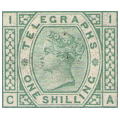 |
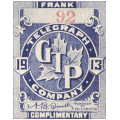 |
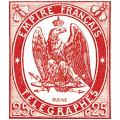 |
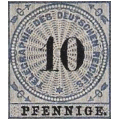 |
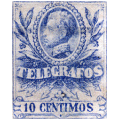 |
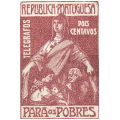 |
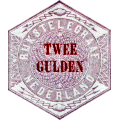 |
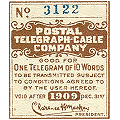 |
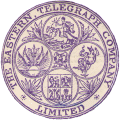 |
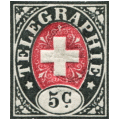 |
 |
| British | Canadian | French | German | Spanish | Portuguese | Netherlands | U.S.A. | Eastern | the rest | Contributions |
| Up a level | ||||||||||
 |
 |
 |
 |
 |
 |
 |
 |
 |
 |
 |
| British | Canadian | French | German | Spanish | Portuguese | Netherlands | U.S.A. | Eastern | the rest | Contributions |
I have brought these prices up to date and added currency selection. CheckList Setup |
Contributors:
|
| Shortcuts to other sections | |||||||
| France | Telegraph Coupons | Telegrams | Telephone Stamps | Pneumatic Post | Guadeloupe | Monaco | French India |
Steve Hiscocks wrote:
Background information on the two stamps listed below has proved elusive. Even their status is in some doubt since one major French
catalogue lists them as telegraph stamps while another includes them with the postage stamps without comment. It has been suggested that the
E.F.M. overprint stands for "Expédition Français Militaire" but this too requires confirmation.
The telegraph was first introduced to Algiers in 1842, initially for military use only until 1854 when there were 1500km of lines.
The telephone was introduced in 1882 by a private company, Société générale des téléphones, operating a network in Algiers and Oran for 7 years.
The PTT took over in 1889 and by 1900 it had an extent of 460km. By 1928 it had increased to 22,600km.
Source: Algeria.com citing 'Le Soir D'Algerie' an Algerian newspaper.
Further information would be welcome.
From 1868 to 1871 the French telegraph stamps (see below) were used for prepayment of telegrams, but these can only be distinguished by the postmarks and are worth a premium.
French stamps used in Algeria.
To be helpful, here are the 20 largest cities in Algeria (biggest at top-left going downwards):
(Full list on Wiki.)
After 1871 cash was used for payment. Similarly the French Telephone stamps were also used in Algeria.
These generally had 'ALGER' as part of the cancel.
1943 Postage stamps of 1936 overprinted "E.F.M." and surcharged "30frs". Perf. 13¼
There are a surprising number of interpretations of exactly what these were used for and what the letters "E. F. M." actually stand for.
Since these were provided by the French, it seems reasonable to suppose that they stand for something in French. In that regard,
The suggestion of "Expédition Français Militaire" would thus sound reasonable.
The Scott catalogue says that these were to pay cable tolls and for use by US and Canadian servicemen and that the letters stood for "Emergency Field Message".
John Barefoot says they were for a service "mainly using radio telegraphy, provided by the Free French for American forces",
the letters standing for "Expeditionary Force Message". Another suggestion is that it means "European Forces Mail".
H.M.S. Hannibal of the Mediterranean Fleet is also listed as based there from June 1943 to June 1944(at least).
The letters "E. F. M." also appeared on French Telegrams used there, so I would be inclined to believe that the "F" stood for "Français"
and that other opinions were offered to avoid giving offence to the badly needed foreign forces.
A 1945 piece shown below suggests that John Barefoot actually got it right, but that may just have been what the U. S. Army thought it meant !
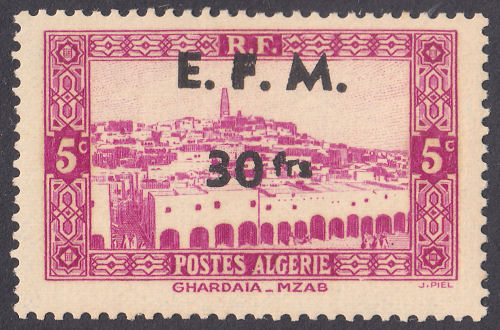 |
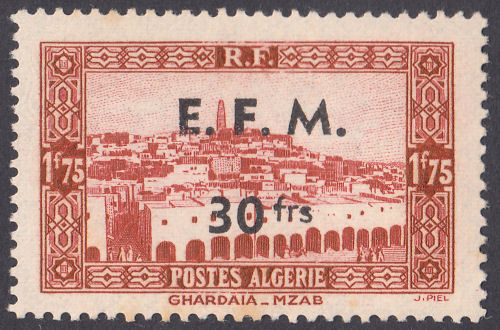 |
| Algeria H1 | Algeria H2 |
Sheets contain 10 rows of 5 stamps.
| Hisc. | Description | Mint | Used |
|---|---|---|---|
| H1 | 30F on 5c deep magenta | 2.50 | 5.00 |
| H1a | overprint inverted | 50.00 | - |
| H2 | 30F on 1F.75 deep brownish red * | 2.50 | 5.00 |
| H2a | overprint inverted | 50.00 | - |
| H2b | overprint in vermilion | 80.00 | - |
| H2c | overprint in vermilion and inverted | 120.00 | - |
* Hiscocks lists this as 1F instead of 1F.75
Hiscocks added the following note:
| Note.
The overprints were often over-inked resulting in filled in '3's, 'F's, etc. These can be found together with normals in the same blocks and should not , in my view, be regarded as separate varieties. |

A rather over-inked example of the overprint showing the selvedge from RL.
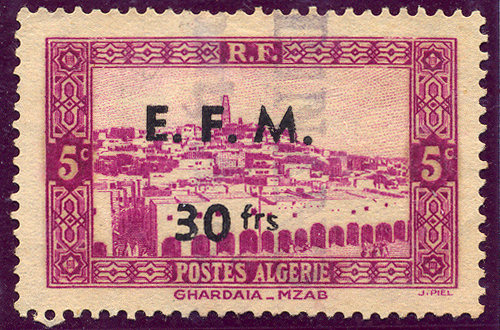
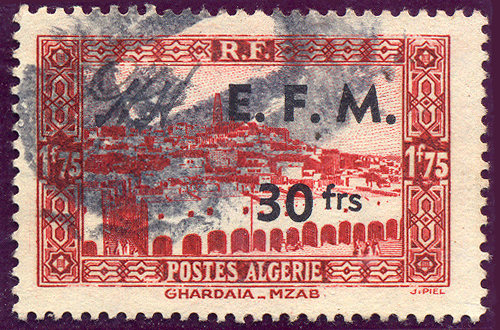
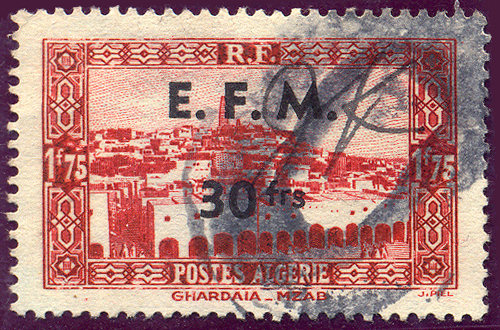
Some used examples from RL.
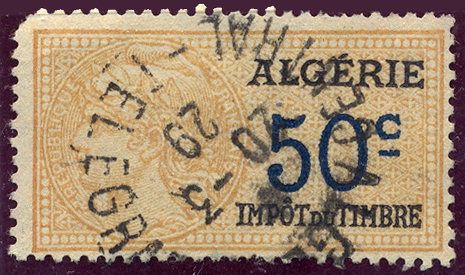
Telegraphic use of an Import Duty stamp dated 20 March 1923, from RL.
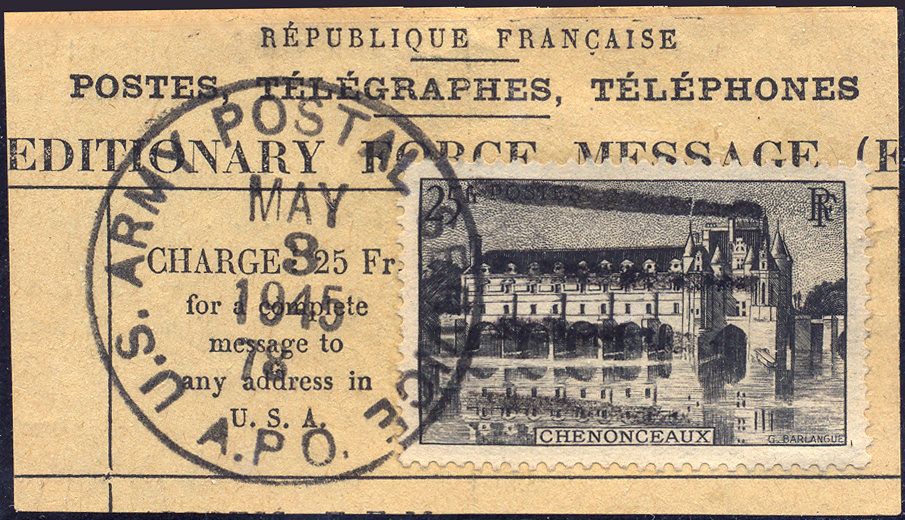
U.S. Army use on 25 Fr postage stamp dated 3 May 1945, from RL, bearing the words :
"Expeditionary Force Message (E.F.M)"
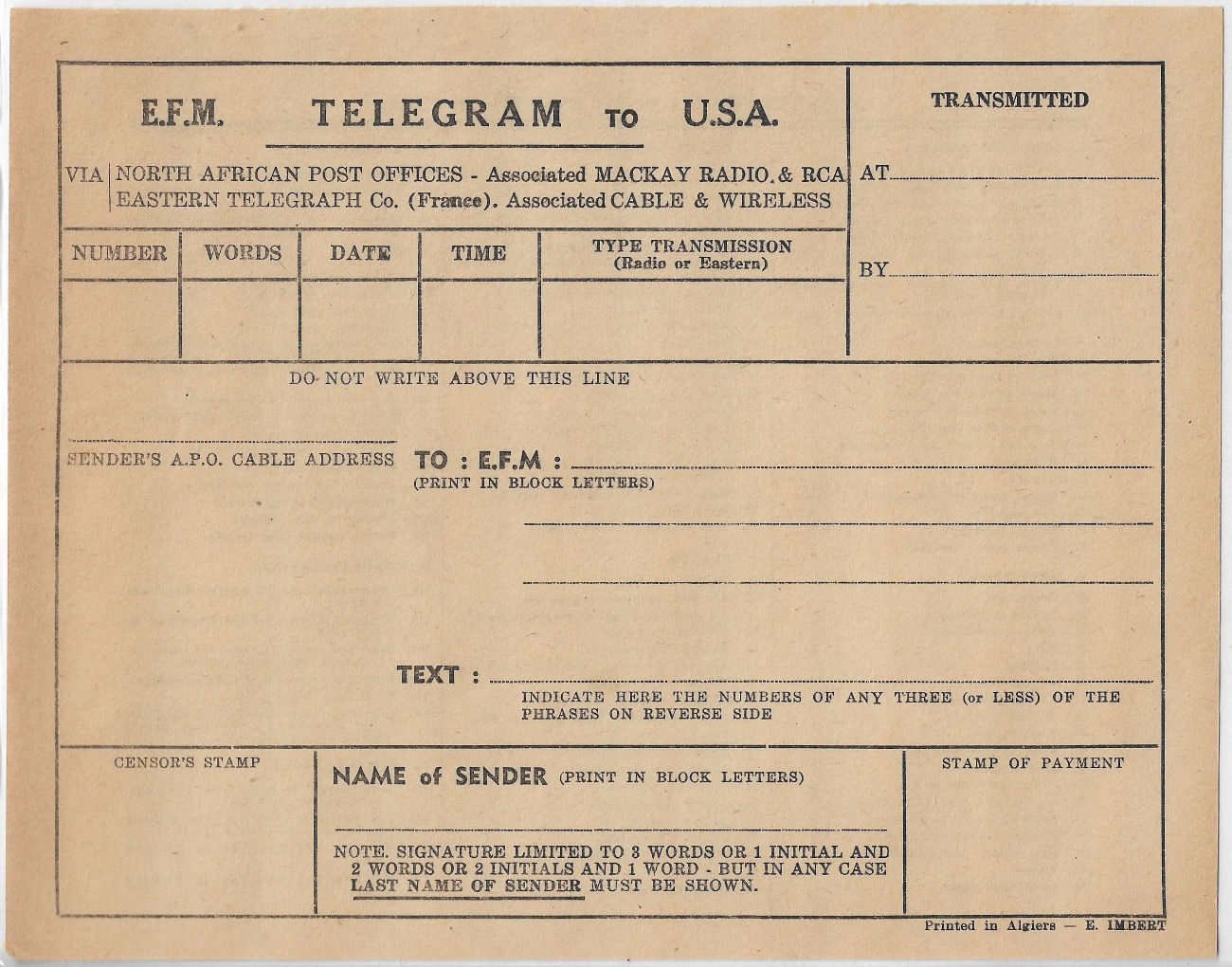
This unused and undated U.S. Army Form has space for hand-stamps in the bottom corners. It requires the sender's "A.P.O. Cable Address".
Note the choice of Mackay Radio/RCA or Eastern Telegraph. Presumably the price was the same. Printed in Algiers by E. Imbert.
The images of front above and back below are courtesy of Mathew Stephenson.
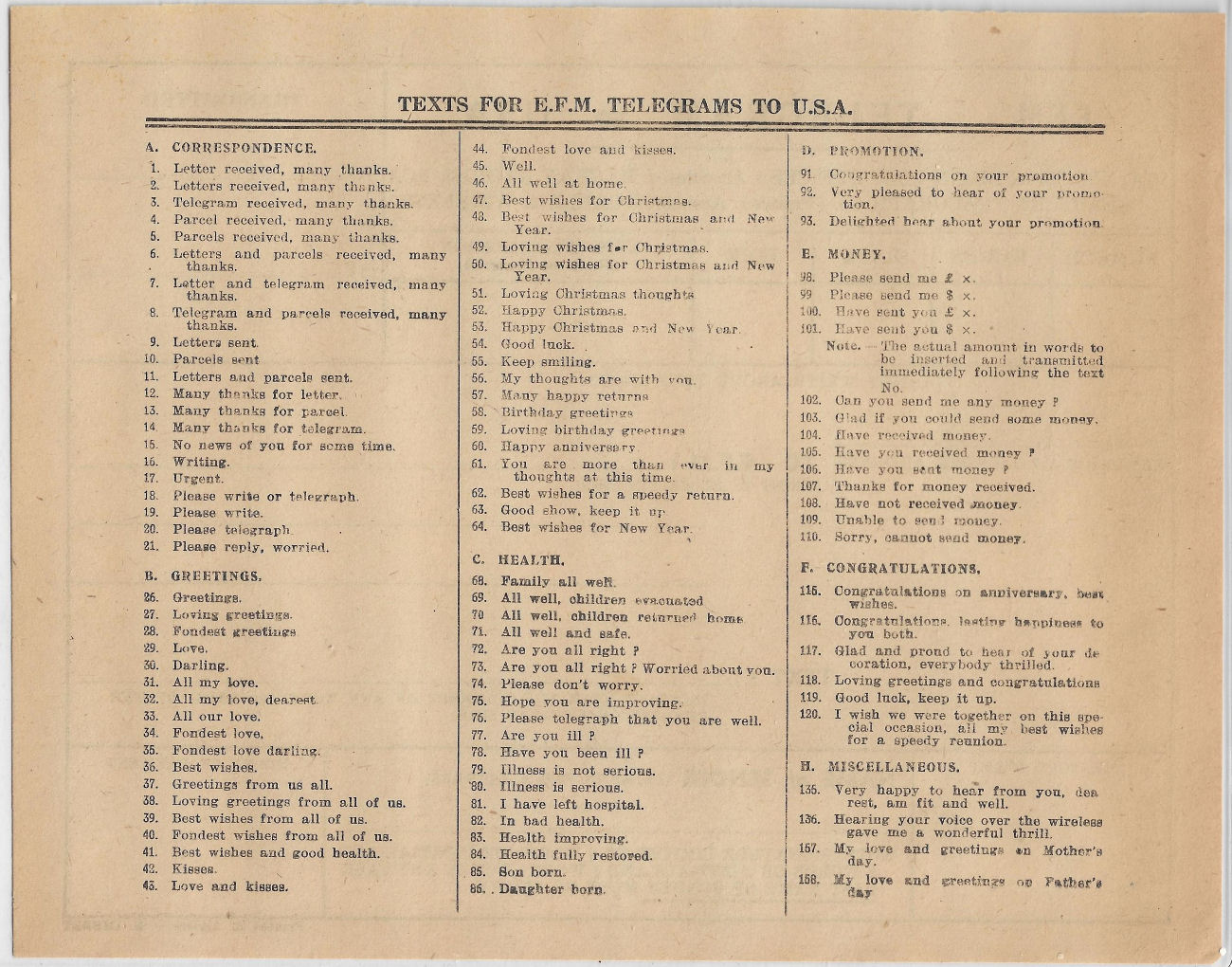
The list of codes on the back goes up to 158, but there are many gaps. The method of using codes, must have made the job of the Censor very easy.
An E. F. M. telegram received by the Eastern Telegraph at Algiers on 24 August 1944 from Rye, East Sussex
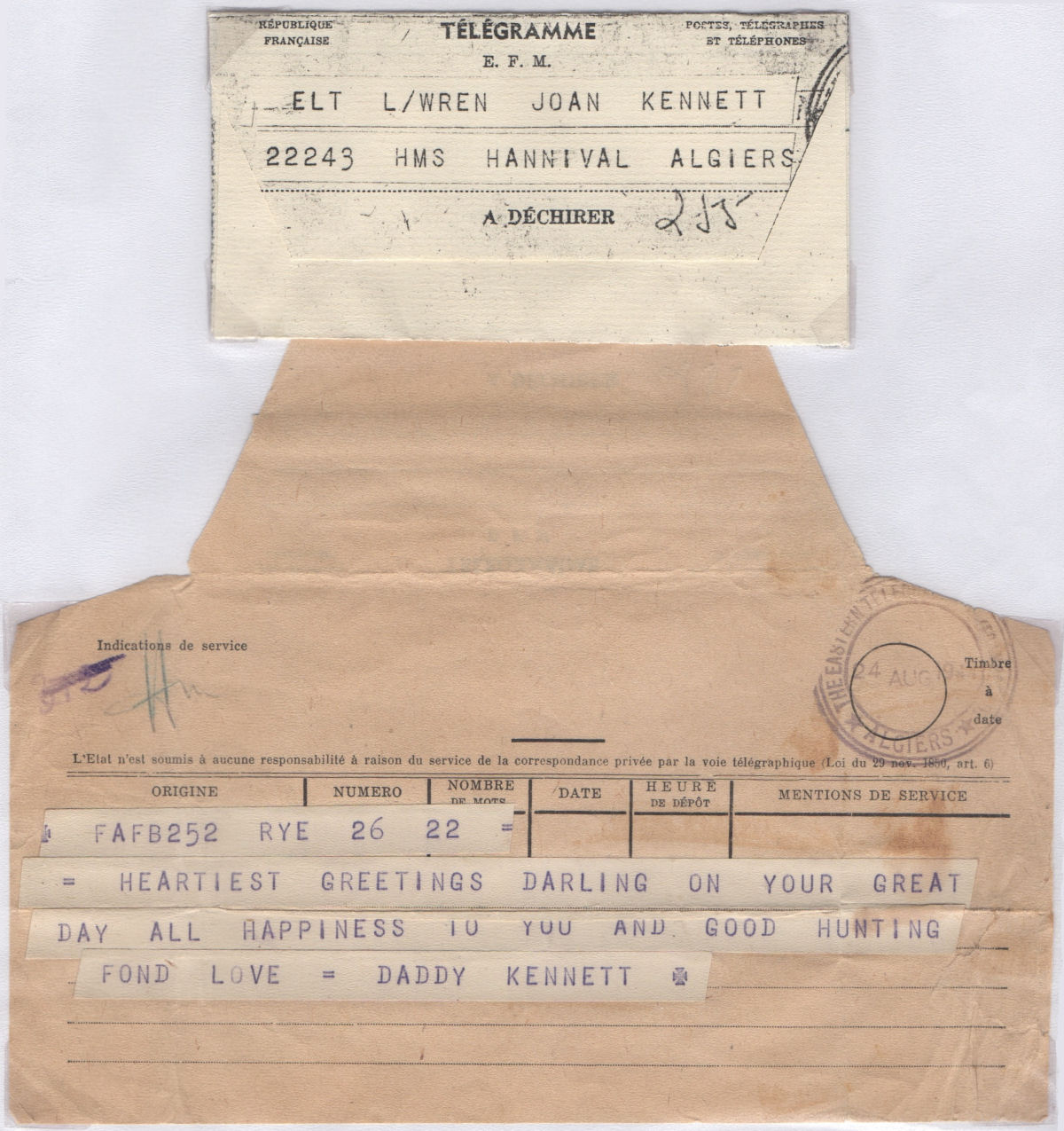
The telegram is to a Wren from her "Daddy Kennett". Images courtesy of Les Bottomley.
Steve Hiscocks wrote:
The use of telegraph stamps in France was proposed to the Government on 14 March 1866. Their adoption was agreed by the legislative assembly on
13 June 1886 but did not receive the Emperor's approval until 8 May 1867. The intention was to make it possible for people to leave prepaid
telegrams at the telegraph office at times when the office was not open. In practice the prepayment was often insufficient because people did
not know the correct rates and the authorities then had the difficult and expensive task of obtaining further payment or returning the cost of the
stamps to the sender. The experiment was thus not seen as a success. A later proposal to reintroduce telegraph stamps in 2F blocks of four (2 x 25c,
1 x 50c and 1 x 1F) together with a 10F stamp, all of designs similar to that issued, apparently came to nothing.
The stamps were designed and engraved by Oudiné whose name appears below the Imperial eagle.
1868 (1 January) Typographed on off-white wove paper, no watermark, imperf.
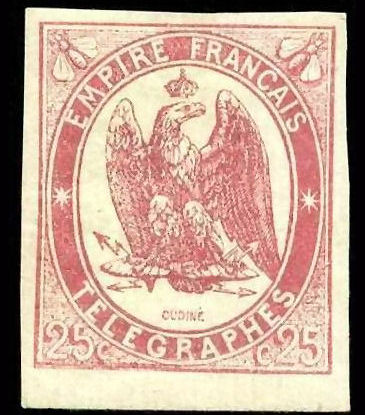 |
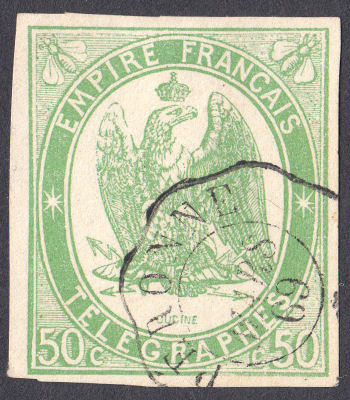 |
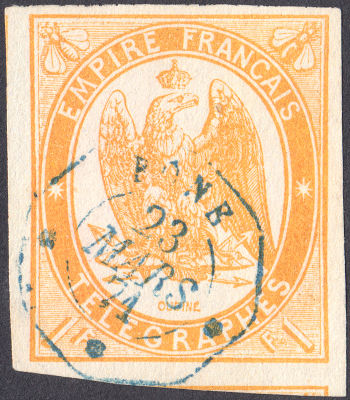 |
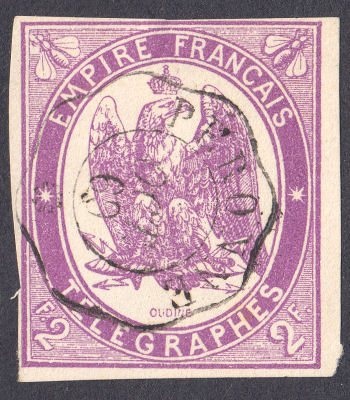 |
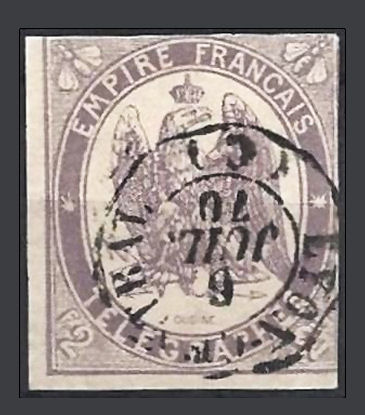 |
| France H1 courtesy Patrice Robin | France H2 | France H3 | France H4 | France H4a courtesy Pierre Paquot |
| Hisc. | Description | Mint | Used |
|---|---|---|---|
| f H1 | 25c rose carmine | 300.00 | 150.00 |
| H2 | 50c dull yellowish green | 300.00 | 120.00 |
| H3 | 1F orange-yellow * | 500.00 | 150.00 |
| f H4 | 2F reddish lilac | 500.00 | 100.00 |
| H4a | deep reddish lilac | 600.00 | 110.00 |
* Hiscocks lists only 'salmon' as a colour for the 1F. I have not yet seen 'salmon' ones, only the colour shown above.
Hiscocks added the following 2 notes:
| Note 1. Nos. 1, 3 and 4 are known as specimens ("ÉPREUVE") - prices about 1.5 x used. |
| Note 2. Cancellations are usually a wavy or simple octagonal date stamp in black or blue. |
f A note of mine: Fournier is known to have produced forgeries of the 25c and 2F at least
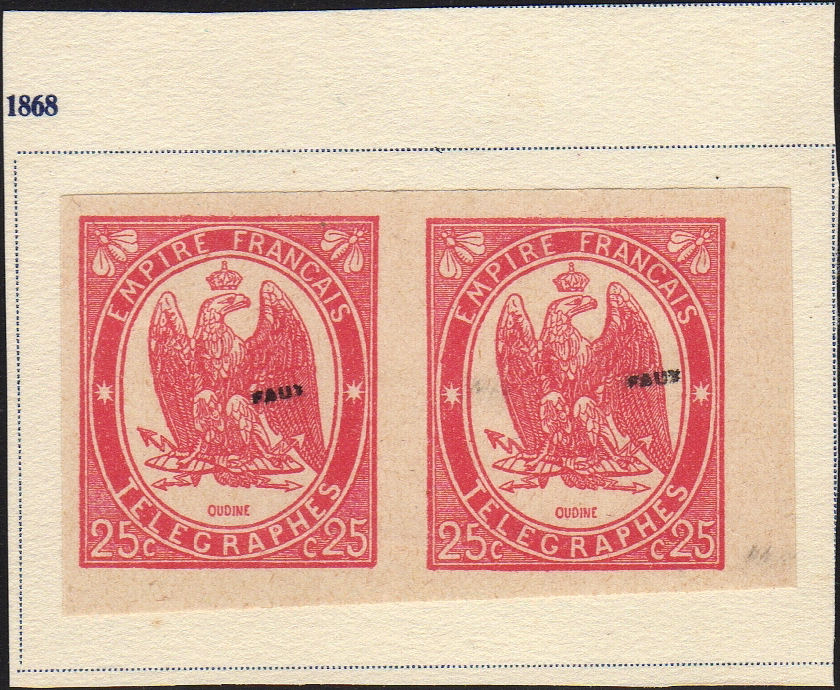
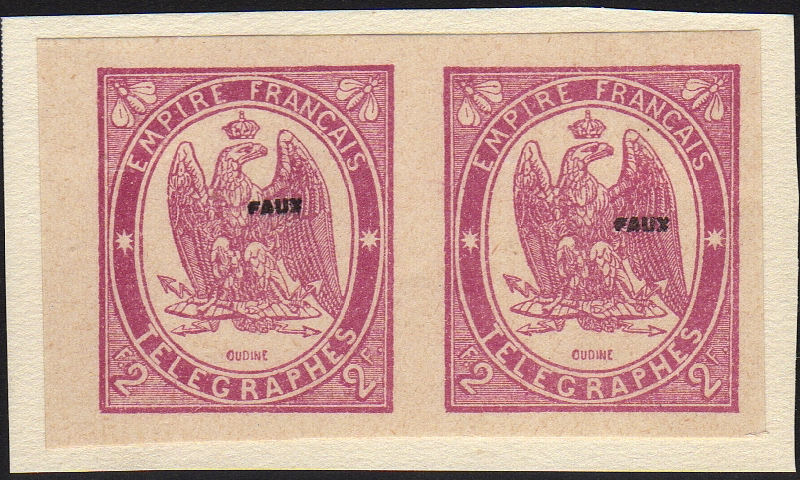
He also forged postmarks and telegraphic cancels:
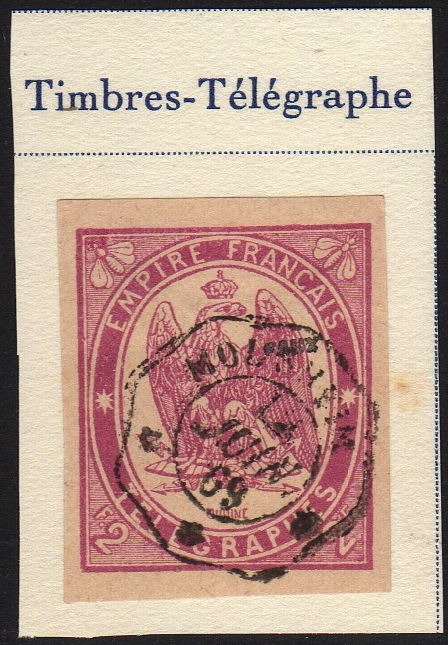
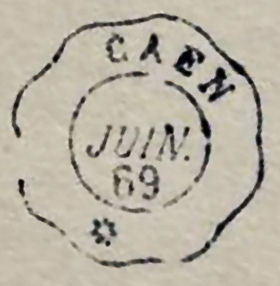
MOLSHEIM and CAEN, both Juin 69.
Note that these stamps are overprinted 'FAUX' (False).
This was not done by François Fournier but by the Union Philatelique de Genève who bought the
remaining stocks in 1927 (10 years after the death of Fournier) and
prepared 480 albums for sale with stamps marked with the words Faux and/or Facsimile.
The stamps sold by François Fournier were not marked in any way to identify them.
Compare the letters of the word 'FRANCAIS' between genuine and Fournier,
particularly 'F', 'C' and 'S' which are more 'closed' on the original and 'open' on the Fourniers.
Fournier stamp illustrations courtesy of Andrew Higson.
Having verified that yours is not a Fournier forgery, there is still something you need to be careful about.
The perforated ones below are sometimes trimmed and passed off as imperforate stamps.
If they are clearly cancelled before 14 January 1868 you should be safe. If not, it may simply be late usage, but you might want to check the size of the stamp.
Look again at the stamps above, which ones would you check ?
1868 (14 January) As above, perf. 11½ x 12½, 12, 12½, 12½ x 12, 12 x 12½ (see note 3 below).
I think a lot of this is down to uneven pin-spacing.
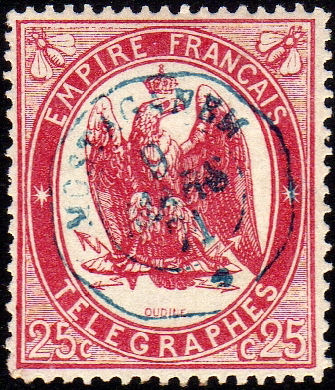 |
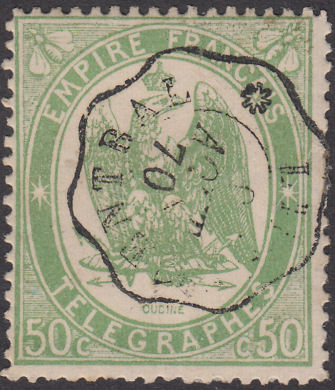 |
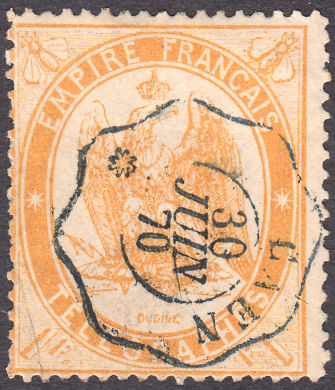 |
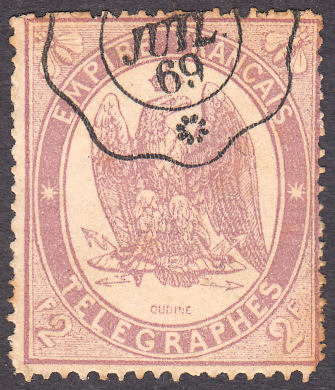 |
| France H5 Perf. 12.2 Blue Algerian cancel Courtesy of Andrew Higson. |
France H6 Perf. 12.2 Seen on 2 x 50c, the other dated 28 Feb 71. |
France H7a Perf. 12.3 x 12.0 Seen on 2 x 1F, the other dated Dec 69. |
France H8b Perf. 12.7 Seen on 2 x 2F, the other dated 18 Nov 68. |
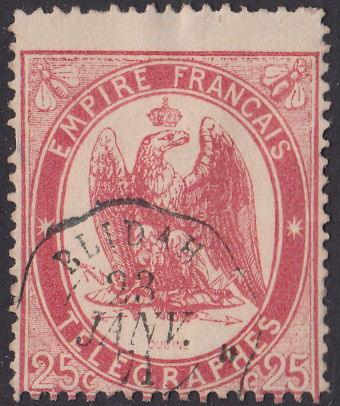 |
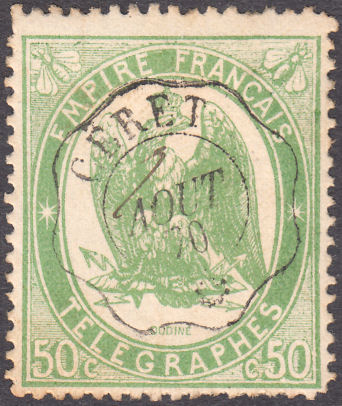 |
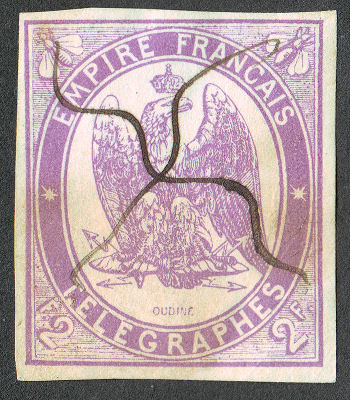 |
| A tall 25c | A tall 50c | A questionable 2F. Imperf. ? Could it have been trimmed ? Check it. |
Some of the stamps are taller than others, but the width seems to be fairly constant.
Could the 2 Franc be a trimmed perforated stamp ?
| Hisc. | Description | Mint | Used |
|---|---|---|---|
| H5 | 25c rose carmine | 400.00 | 40.00 |
| H5a | rose | 400.00 | 40.00 |
| H6 | 50c dull yellowish green | 150.00 | 10.00 |
| H6a | bright green | 150.00 | 10.00 |
| H7 | 1F salmon | 150.00 | 20.00 |
| H7a | yellow-orange | 160.00 | 15.00 |
| H7b | pale orange | 160.00 | 15.00 |
| H8 | 2F reddish lilac | 200.00 | 20.00 |
| H8a | reddish purple | 200.00 | 24.00 |
| H8b | pale reddish lilac | 200.00 | 20.00 |
These were withdrawn in 1871. The latest cancel I have seen being 23 March.
Hiscocks added the following 3 notes:
| Note 1. Nos. 6, 7 and 8 are known as specimens: prices about £25 each. [say £50 now] |
| Note 2. Cancellations as for Nos. 1-4. |
| Note 3. It is not at present clear which perforations exist for which values. Perf. 12 is said to be the most common. |
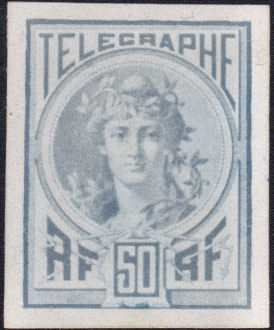
Considering the failure of the previous issue, it is unlikely that there would be essays for another attempt.
This essay must be 1870 or later, since it is inscribed 'RF', Republic of France, rather than Empire of France as the first issue.
It may be an essay for the later Telephone stamps or Pneumatic Post however.
Any information on this would be welcome.
This company was created by a French financier to provide France with its own connection to the USA.
The connection linked Paris to Cape Cod via Louisbourg, Cape Breton Island and St.Pierre.
It was functional from late 1879 until 1895 when the company merged with
La Société Française de Télégraphes Sous-Marin to form La Compagnie Française des Câbles Télégraphiques.
It appears to have provided shareholders with the French equivalent of the American Free Franks.
The "Action No" would thgen be the equivalent to the number on all franks of a booklet in the U.S.A.
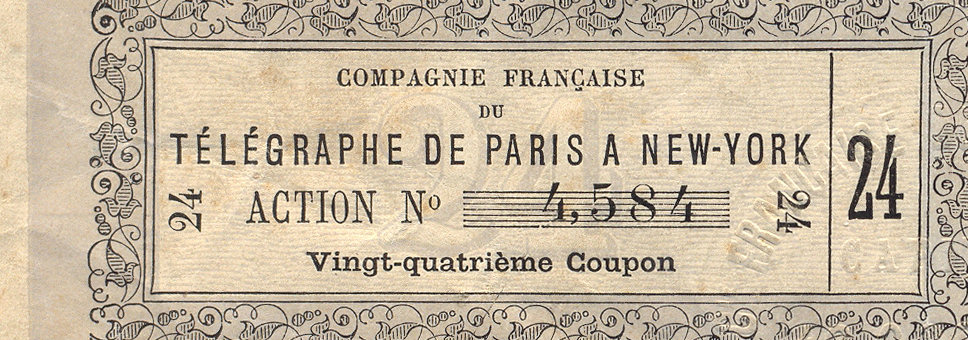
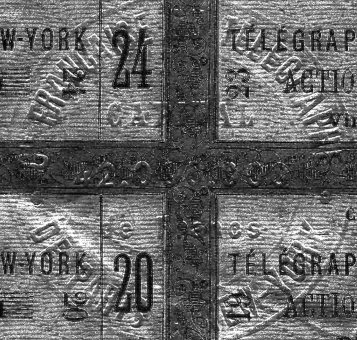
The coupons were in sheets of 32 (at least) individually numbered, with embossing that says "Co FRANCAISE DU TÉLÉGRAPHE DE PARIS A NEW-YORK" in a circle,
containing "CAPITAL 42.036.000 de Francs", suggesting to me that it was aimed at shareholders.
The New-York end of the operation appears to have been the American Union Telegraph Co.(literally those that had been battling the Confederate telegraphs.)
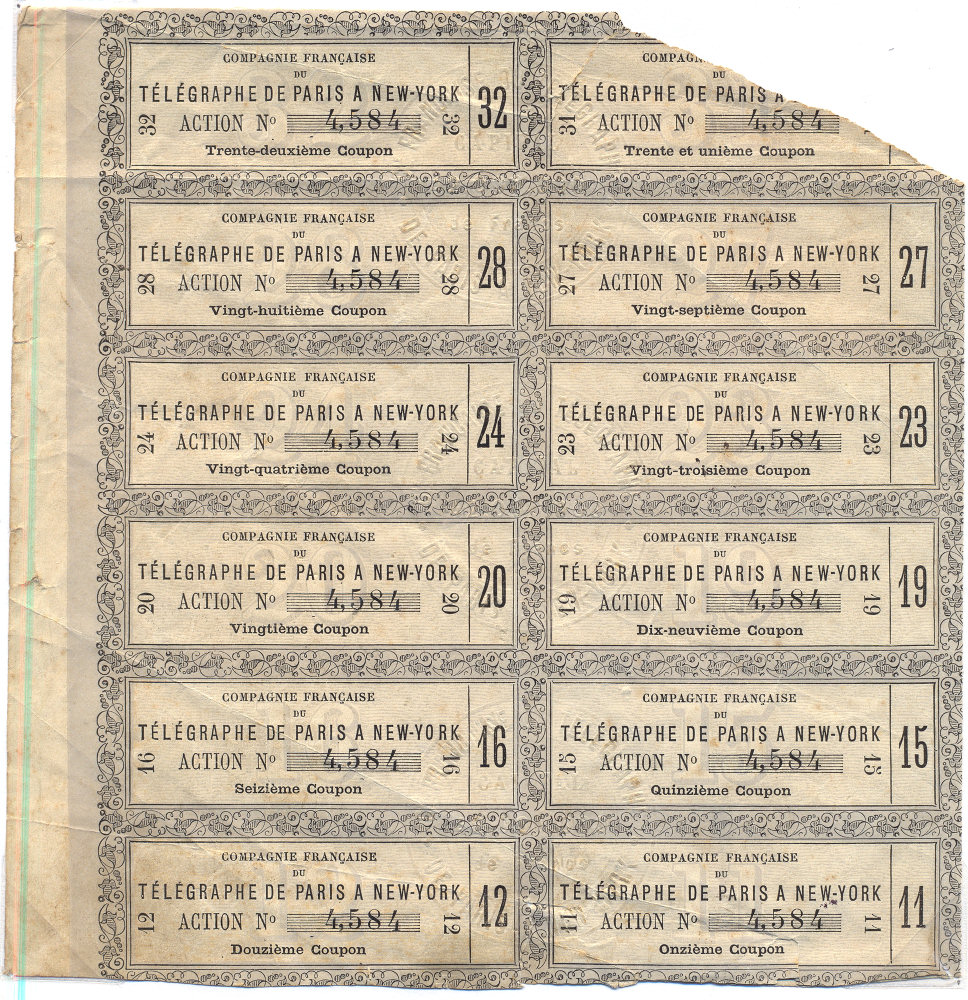 |
[Newspaper]
The New York Times
New York, NY, United States, Sunday, February 20, 1881 - p. 12 FIGHTING THE MONOPOLY ANOTHER INJUNCTION AGAINST THE WESTERN UNION. THE FRENCH CABLE COMPANY BRINGS A SUIT IN THE UNITED STATES COURTS — THE GROUNDS OF THEIR COMPLAINT — JUDGE BLATCHFORD'S ORDER. Another legal impediment was yesterday placed in the way of the consummation of the telegraph consolidation. The Compagnie Francaise du Telegraphe de Paris a New-York, commonly known as the French cable company, began a suit in the United States Circuit Court against the American Union, Atlantic and Pacific, and Western Union Telegraph Companies, and the Union Trust Company, and before noon Judge Blatchford granted a temporary injunction, which practically checks until the further order of the court the doing of any act whatever by any of the defendants looking to the completion of the arrangements for consolidation. The general features of the cause of action held by the French company against the defendant, the American Union Company, are similar to those in the recent action by the Direct United States Cable Company against the Atlantic and Pacific Company and the other defendants named. In June, 1879, the French company and the American Union entered into an agreement with each other for the exclusive interchange of business, the former being the only cable company and the latter the only land telegraph company which had not at that time entered into some such compact. This contract was made to run for 20 years. The contract went into effect on Jan. 23, 1880, the date when the French cable was completed, and the American Union Company observed the conditions of the agreement up to a few days ago. On Jan. 19 this year the telegraphic consolidation was agreed to by a contract between the three telegraph companies defendant, and the French Company avers that the Western Union Company, under the terms of that agreement, has undertaken three exclusive and hostile agreements which it cannot perform or keep, and which will render it impossible for the American Union or the Atlantic and Pacific Company to keep their contracts relating to the exclusive interchange of business between the various land lines on the one side and the cable companies of the other. This, the complainants allege, will retard and their business and hamper their efforts to furnish cheap telegraphy to the United States. On learning through the press and from other sources that the combination was being formed, Baron P. Cambourg, Manager of the French company, addressed a letter to Mr. D. H. Bates, First Vice-President of the American Union, in which he said: "I have just received from our General Manager the following telegram: 'Please deliver following telegram to Mr. D. H. Bates, President of the American Union Telegraph Company, New York: " 'We have not received any information from you regarding the amalgamation of your company with the other land line companies. Please let us know to what extent the cable companies will be affected by it. What will become of our exclusive contract with you, and how will be considered our agreement with your company ? " 'Are the new cables of Mr. Jay Gould to be laid ? What are the arrangements, and what will be the communications in America of same ? " 'We trust in you to protect the rights of the Compagnie Francaise du Telegraphe de Paris a New-York. " 'Please be kind enough to send answer by cable with the least delay.' " On Feb. 7 Mr. Bates sent to Baron Cambourg the following reply: "Your communication of Feb. 3, inclosing copy of telegram form your General Manager to my address, asking for information regarding the amalgamation of this company with other land line companies has been received. In reply thereto, I beg to say that an amalgamation between your company and the Anglo-American and the Direct United States Cable Companies was announced in the public prints several months ago, but the facts and details in regard to it have not been communicated to us by your company, nor have we been informed how such consolidation of interests between the cable companies will affect this company. "The inquires relative to the new cables should be made to the American Cable Construction Company, which company, I am informed, has engaged to lay them." To this Baron Cambourg sent , on Feb. 9, the following response to Mr. Bates: "I beg to acknowledge the receipt of your letter dated 7th inst., and I am sorry to say that I cannot agree with your statement regarding the so-called amalgamation of our company with the English cable companies. On Oct. 12, 1880, and as soon as I had received by with the full copy of our agreement with the English companies, I communicated it at once to Gen. Eckert, according to my instructions, giving him at the same time assurances that our contract with the American Union Telegraph Company would not be affected. About a fortnight after I received a printed copy of the same agreement and supplementary agreement, with directions to deliver it to Gen. Eckert, actual President of the American Union Telegraph Company, which I did. I had, a few days after, a conversation with yourself about that contract, the details of which you seemed to know very well at the time. I call your attention to the questions propounded by my company, which you have not yet answered." Since the sending of this letter the French company has received no reply, either verbal or written, from the American Union Company. The complainant sets up the provisions of the act of Congress relating to telegraph companies passed July 24, 1866, with the amendments thereto, giving all such companies the right to use the military and post roads of the Government, and the public domain, and forbidding any company, on the acceptance of such privileges, from transferring its rights or privileges to any other parties whatever. For these reasons the complainant avers that the consolidation is and will be illegal, null, and void, and contrary to public law and public policy, as well as in derogation of the rights of complainant. The attorneys for the plaintiff are Senator George F. Edmonds, Clarence A. Seward, Joseph H. Choate, Lewis L. Delafield, and Charles M. DaCosta. On their pleadings and affidavits accompanying them, which set out in great detail the facts above outlined, Judge Blatchford yesterday granted a preliminary injunction restraining the American Union Company from delivering, and the Western Union Company from receiving, any of the property, franchises, or contracts of the former company; also restraining the Western Union from changing, disposing of, or in any manner incumbering any of the franchises or property of the American Union, and the receipt or delivery of stock or certificates of stock, in furtherance of the consolidation through the Union Trust Company as Trustee, is also enjoined and prohibited. The return of the order is set down for Thursday next, the same time as the hearing is fixed for on the motion to continue the injunction pending litigation in the case of the Direct Cable Company against the same defendants. -- |
| Anyone have anything similar ? Images courtesy of RL. |
Notes : The International Ocean Telegraph had a similar exclusive Act of Congress passed on 5 May 1866, giving it 14 years of all Cuban traffic. David Homer Bates : U.S._Military_Telegraph_Corps |
This form confusingly has a 1F telegraph stamp stuck on it. However it does not belong, as the form number on the left includes the date of September 1920.
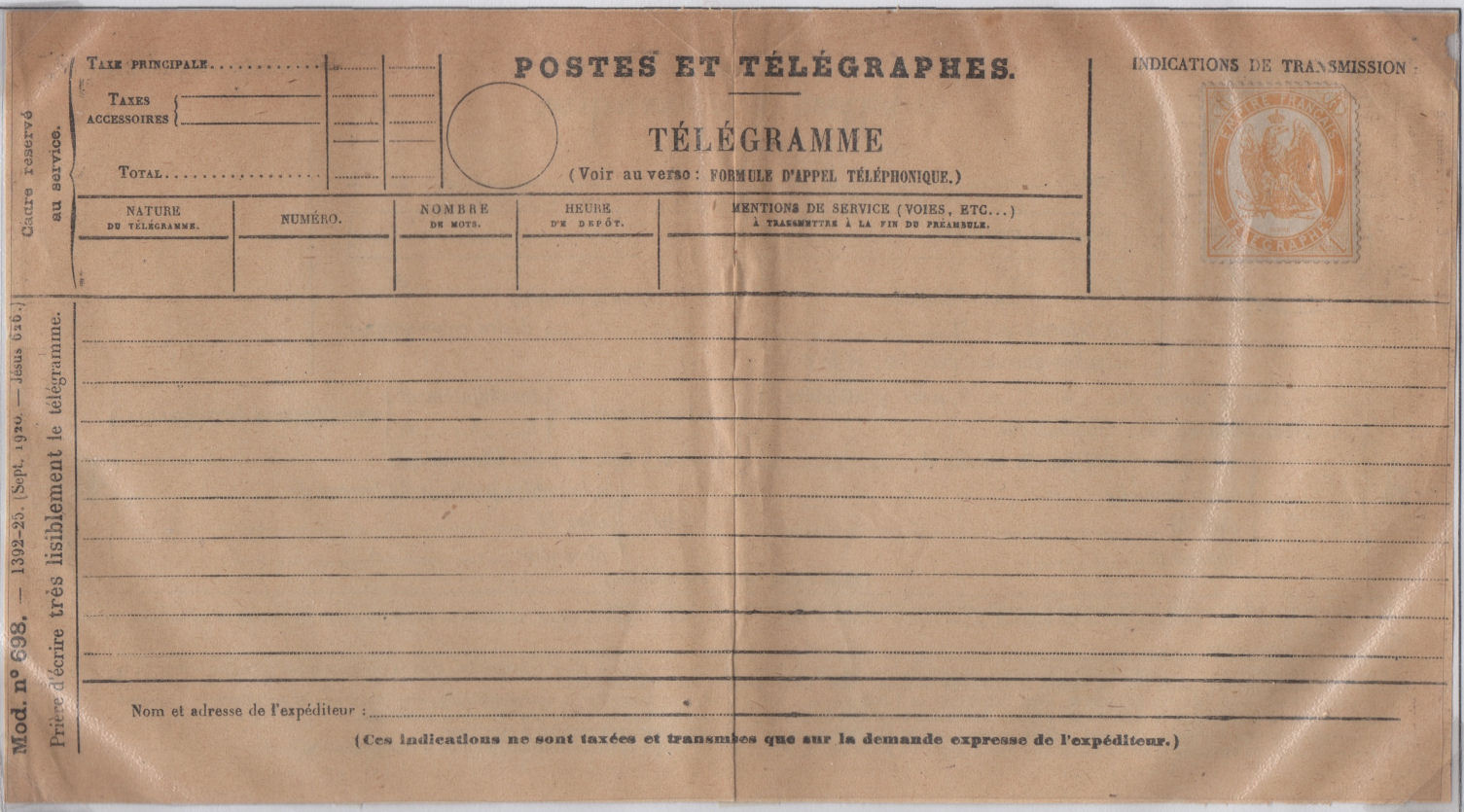
The full form number is "698. — 1392-25. (Sept. 1920. — Jésus 626.)". Below "TÉLÉGRAMME" it has "(Voir au verso: FORMULE D'APPEL TÉLÉPHONIQUE.)" or "(See overleaf: TELEPHONE CALL FORM.)"
Image courtesy of Les Bottomley.
This piece has two telegraph stamps stuck on it that are not tied. They do though at least have the same type cancel and date of 3 March 1870.
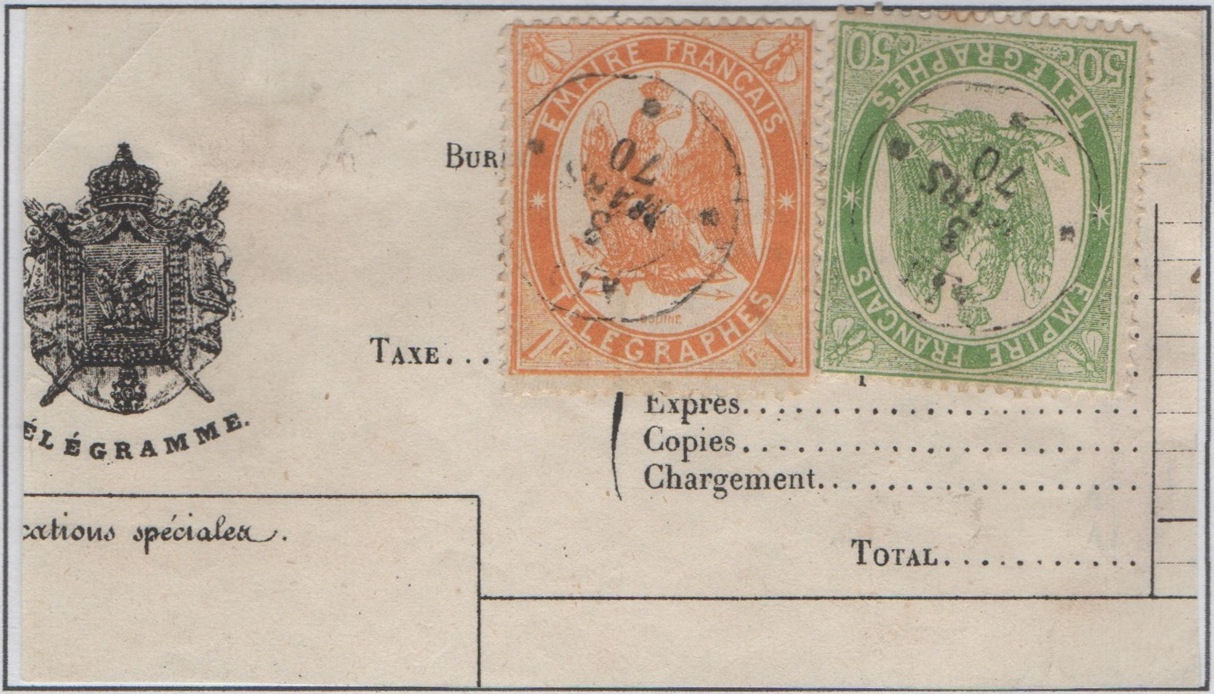
The form also has an Imperial Seal, so is from the right time period. Image courtesy of Les Bottomley.
Anyone have a matching unused form ?
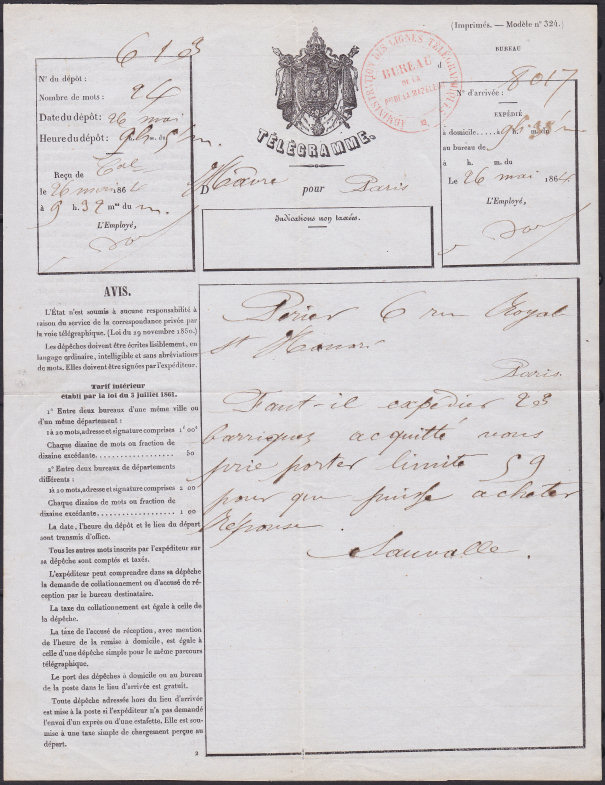
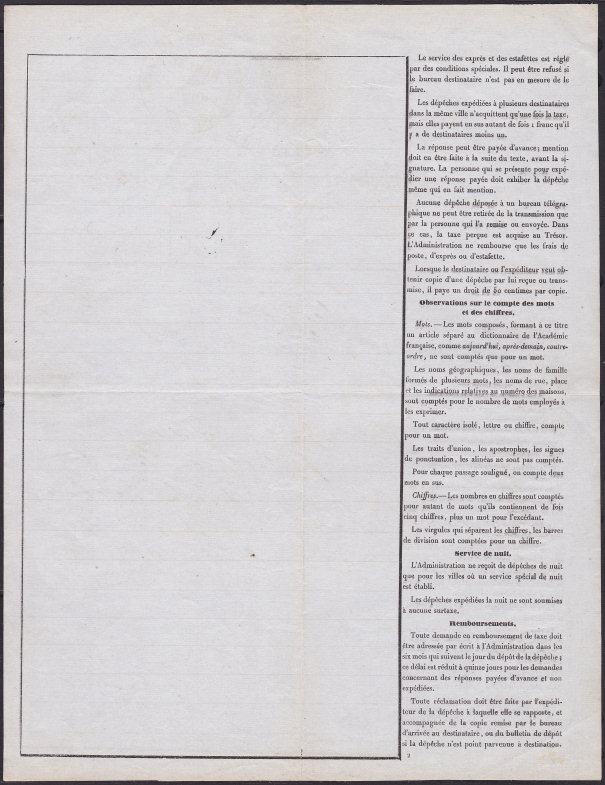
Telegram of May 1864. The top-right has the form number of 324. There are extensive terms and conditions.
Click them for larger images, you may want to use <control>+ and <control>- to scale them on your screen.
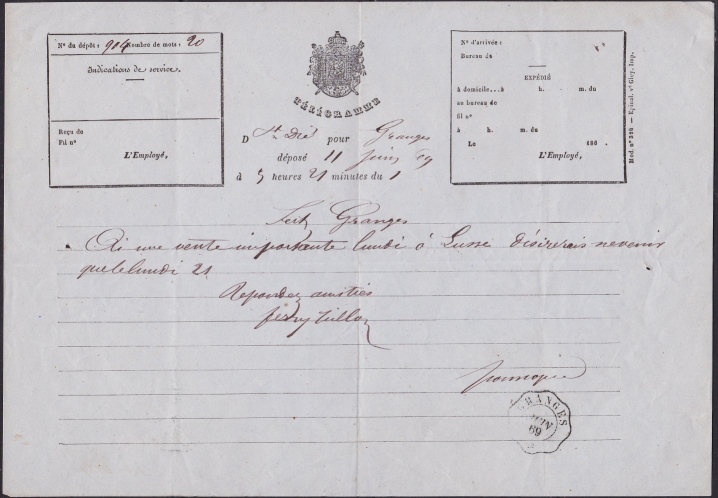
Telegram of June 1869. The top-right has the form number of 324. There are no terms and conditions.
The back is blank. Click it for a larger image.
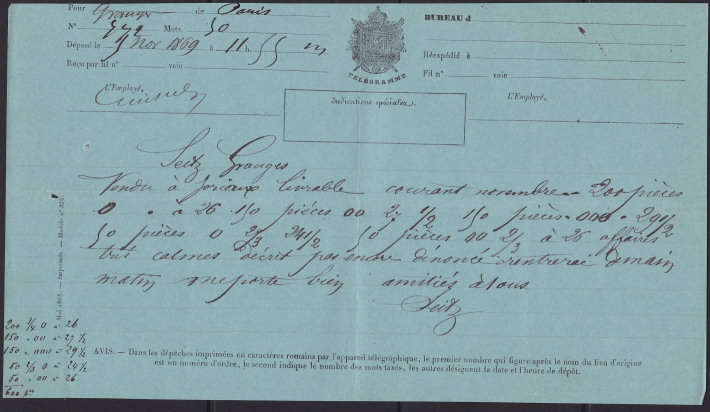
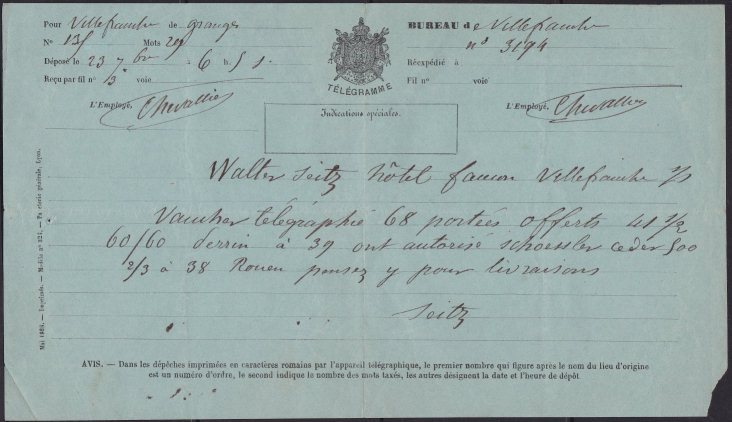
A blue Telegram of November 1869 and a green one without clear date. The bottom-left has the form number of 324, together with a date of printing of May 1868.
The back is blank. Click them for larger images.
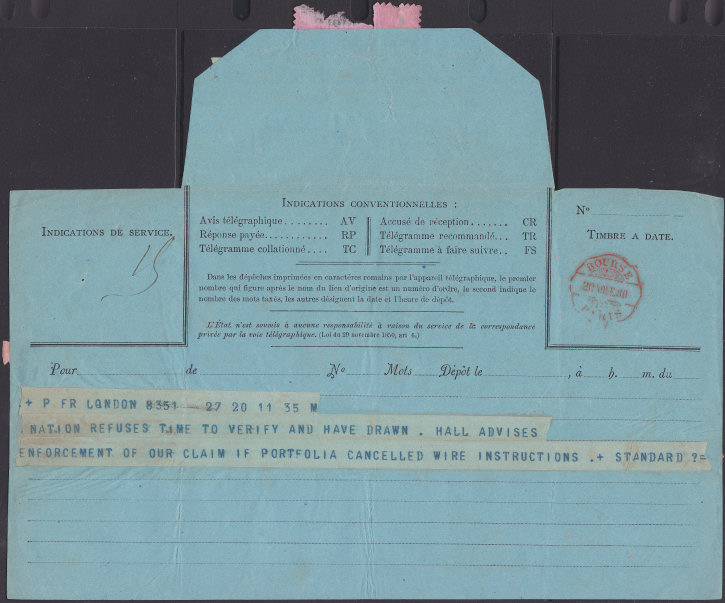
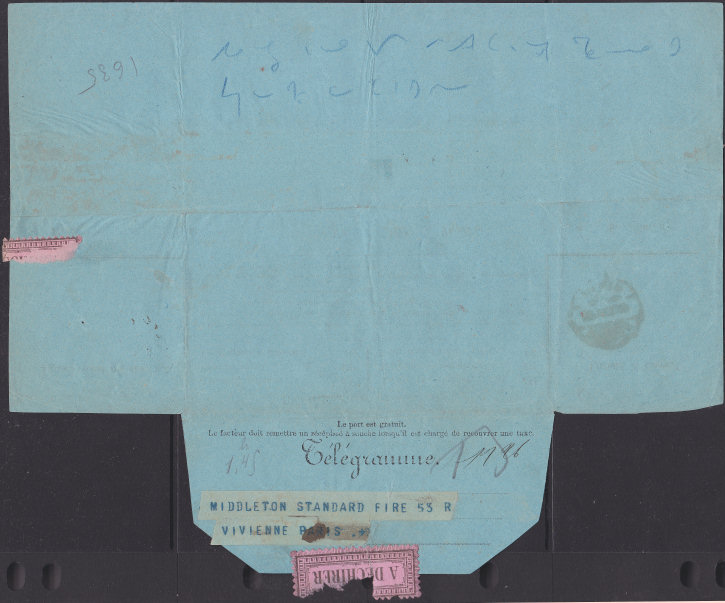
A blue Telegram used 20 November 1880 at the Paris Bourse. There is no form number. It has an unusual pink seal used to
seal it after folding. Click it for a larger image.
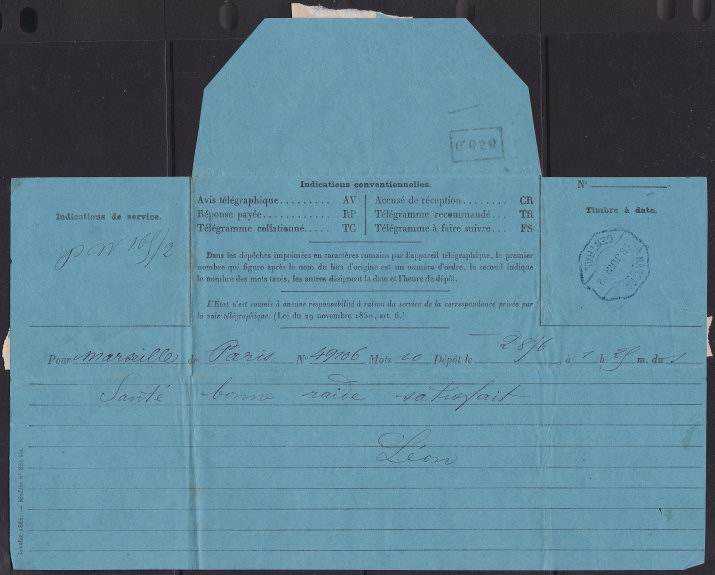
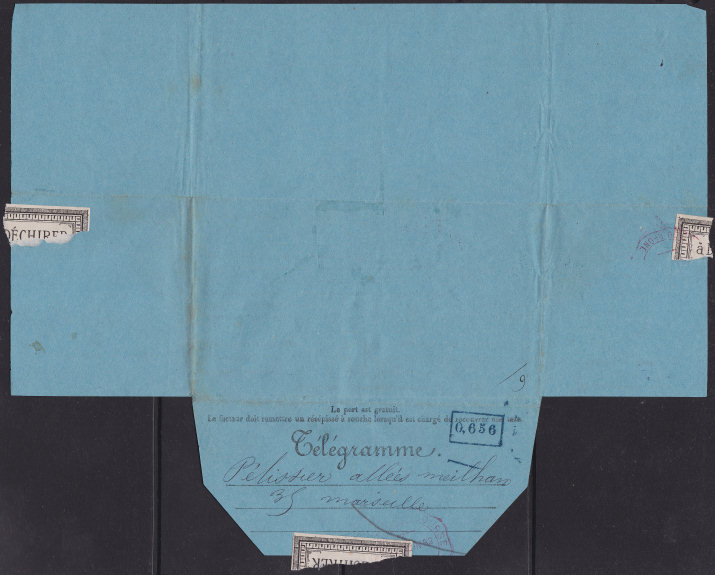
A blue Telegram used 28 June 1882. The bottom-left has the form number of 324, together with a date of printing of January 1882.
Other printing dates I have seen with no noticeable difference, are July 1880, January 1883 and January 1885.
Apart from having the form number and printing date, these differ from the last in the font used for the last printed line.
Click them for larger images.
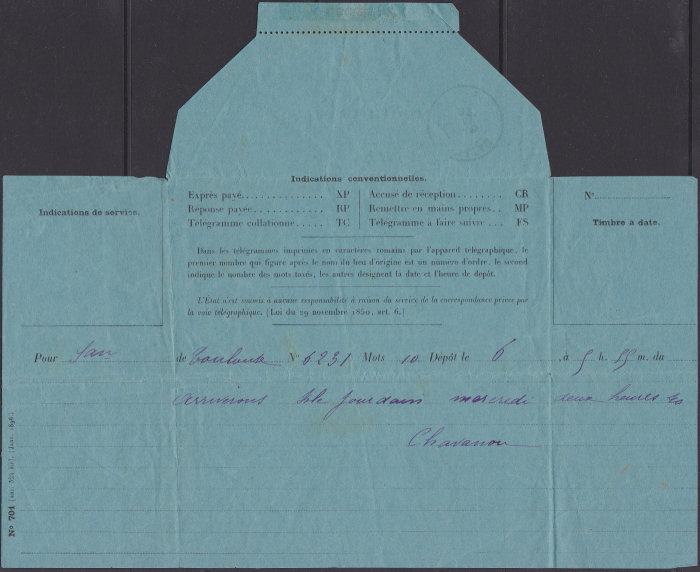
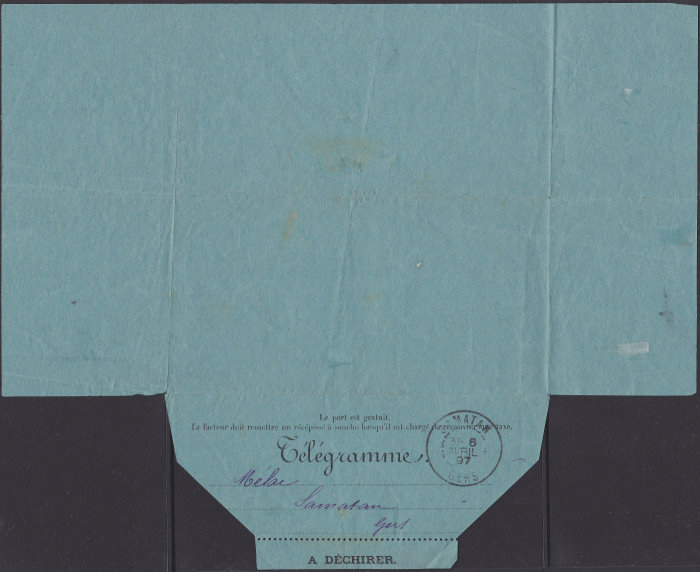
A blue Telegram used 6 April 1897. The bottom-left has the form number of 324, together with a date of printing of January 1896.
I have a similar one in slate-blue dated January 1897. These have an added gummed part for closure, so that separate seals were no longer required.
It has the words "A Déchirer" meaning to tear or rip, the same as the seals did. Click the images for larger versions.
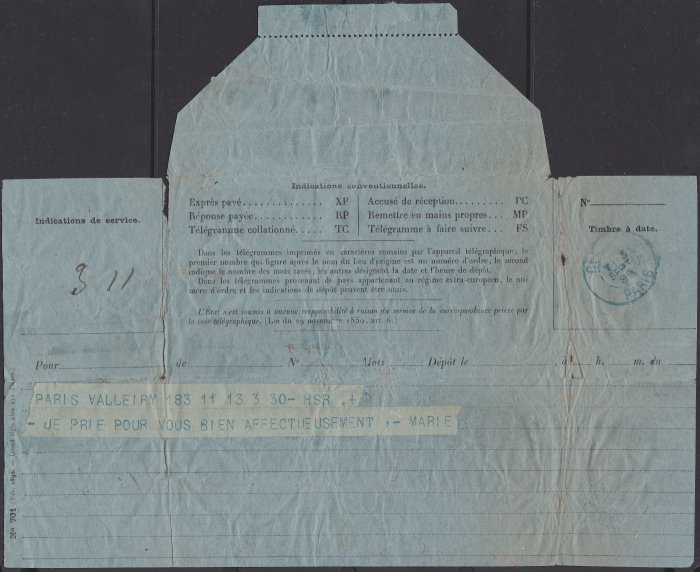
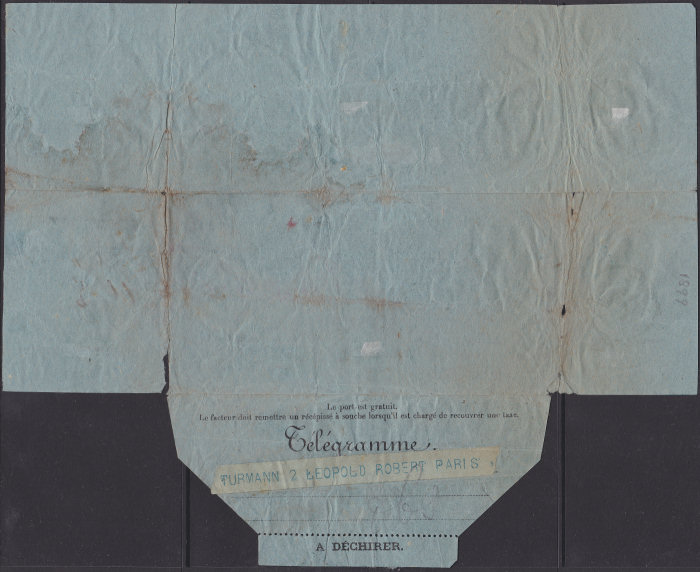
A blue Telegram used September 1899. It is very similar to the last, but the imprint is dated February 1898 and includes
the words "Grand aigle bleu" (Big blue eagle). Click the images for larger versions.
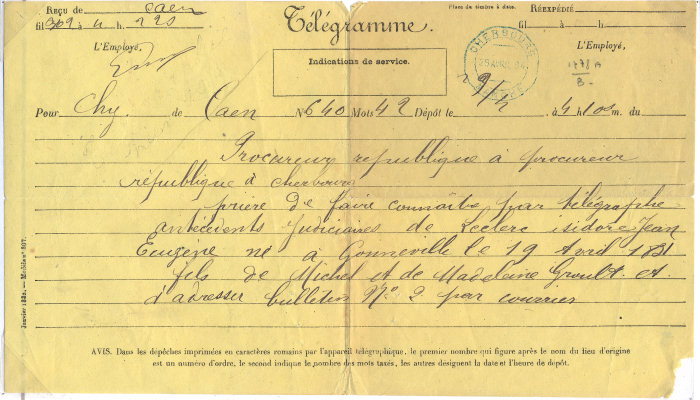
A Telegram used 29 April 1884. It is a different form number, 307, printed January 1882. This was used in Cherbourg, Manche.
Click the image for a larger version - courtesy of RL.
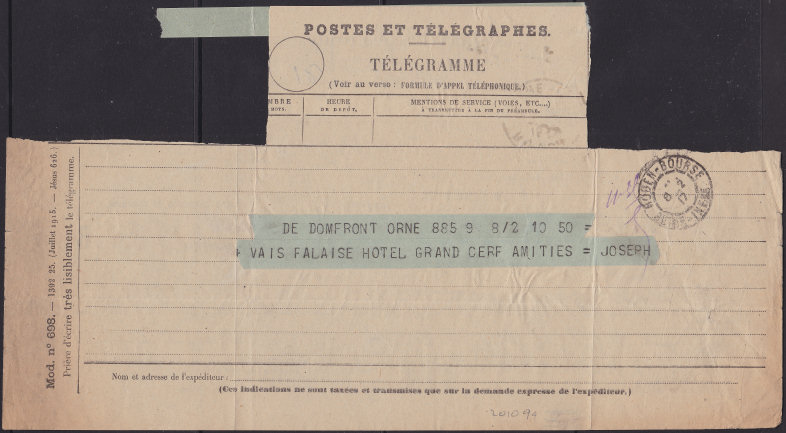
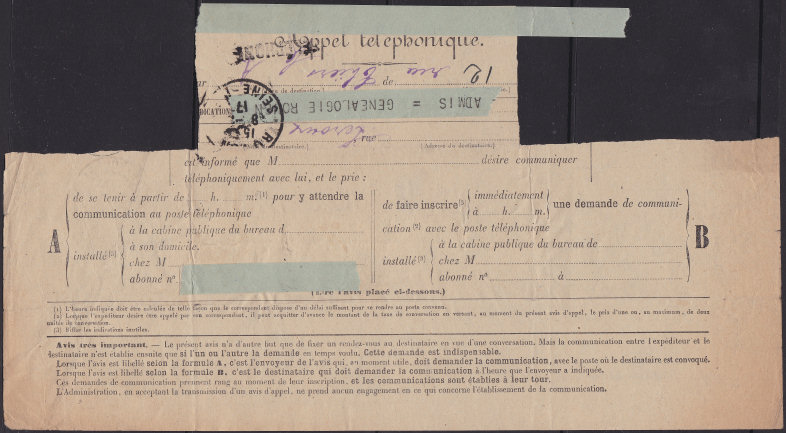
A Telegram used 8 February 1917 at Rouen Bourse. The imprint has form number 698 dated July 1915 and pieces have been torn out to make folding easier.
This is using a piece of 'ticker tape' as a seal. Click the images for larger versions.
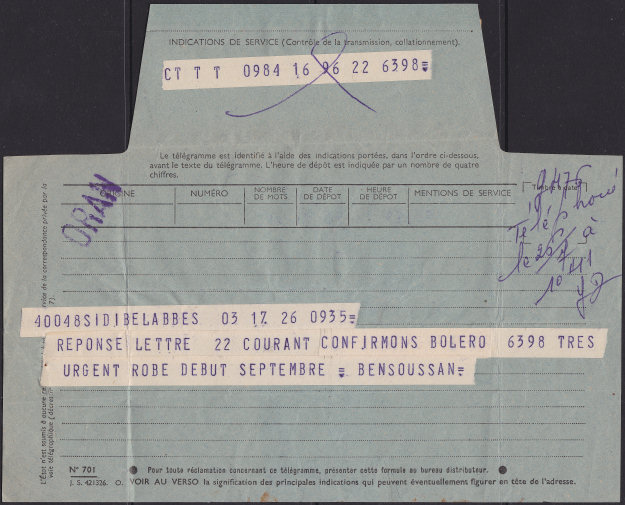
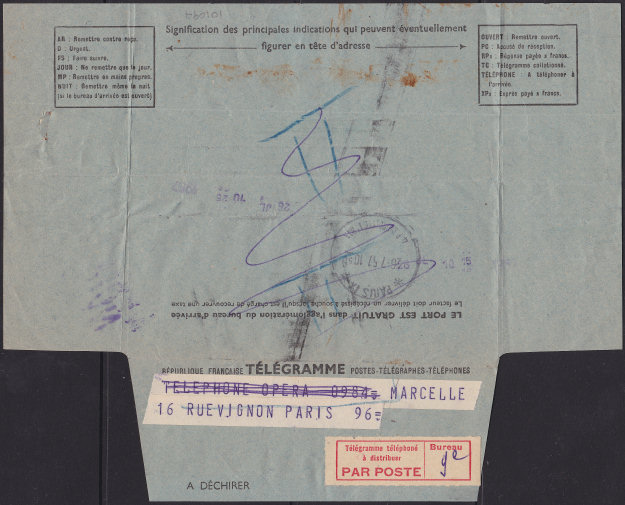
A blue Telegram used in Paris IX on 26 July 1957. The "No 701" may be the form number but I don't see a date.
This now has a gummed edge to close the folded form, with a seal used as an 'etiquette'. Click the images for larger versions.
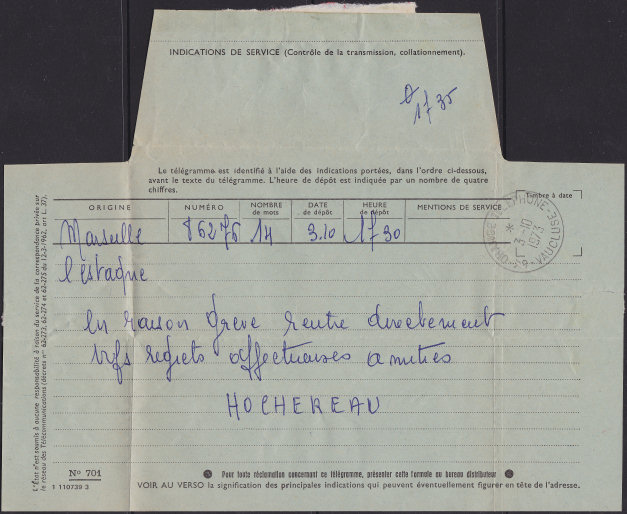
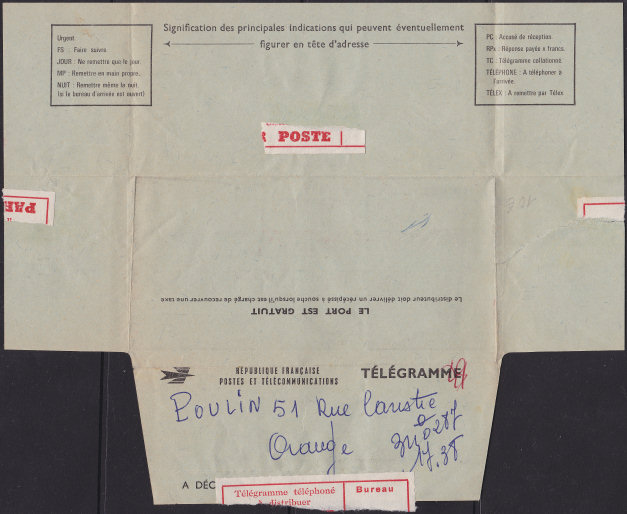
A blue Telegram used in Vauclose (Orange Telephone) on 3 October 1973. The "No 701" may be the form number and the imprint
includes the date of 12-3-1962, but that is probably not the printing date. The gummed edge was used, with a seal used additionally.
Click the images for larger versions.
A sending form marked "No 698"
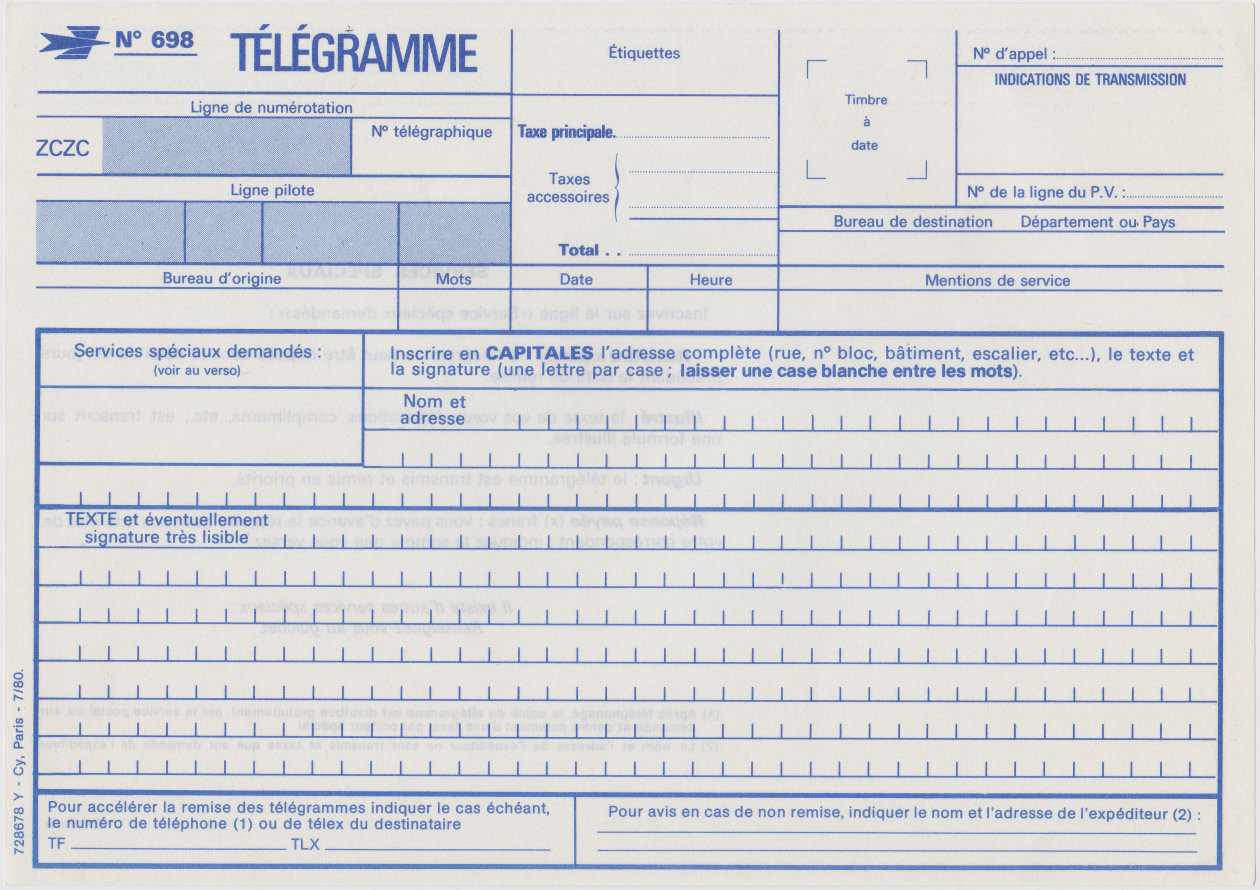
Up the side at bottom-left is "728678 Y - Cy Paris - 7/80". I take "Cy" to identify the printer and "7/80" to indicate July 1980 as the printing date.
The back indicates Special Services available.
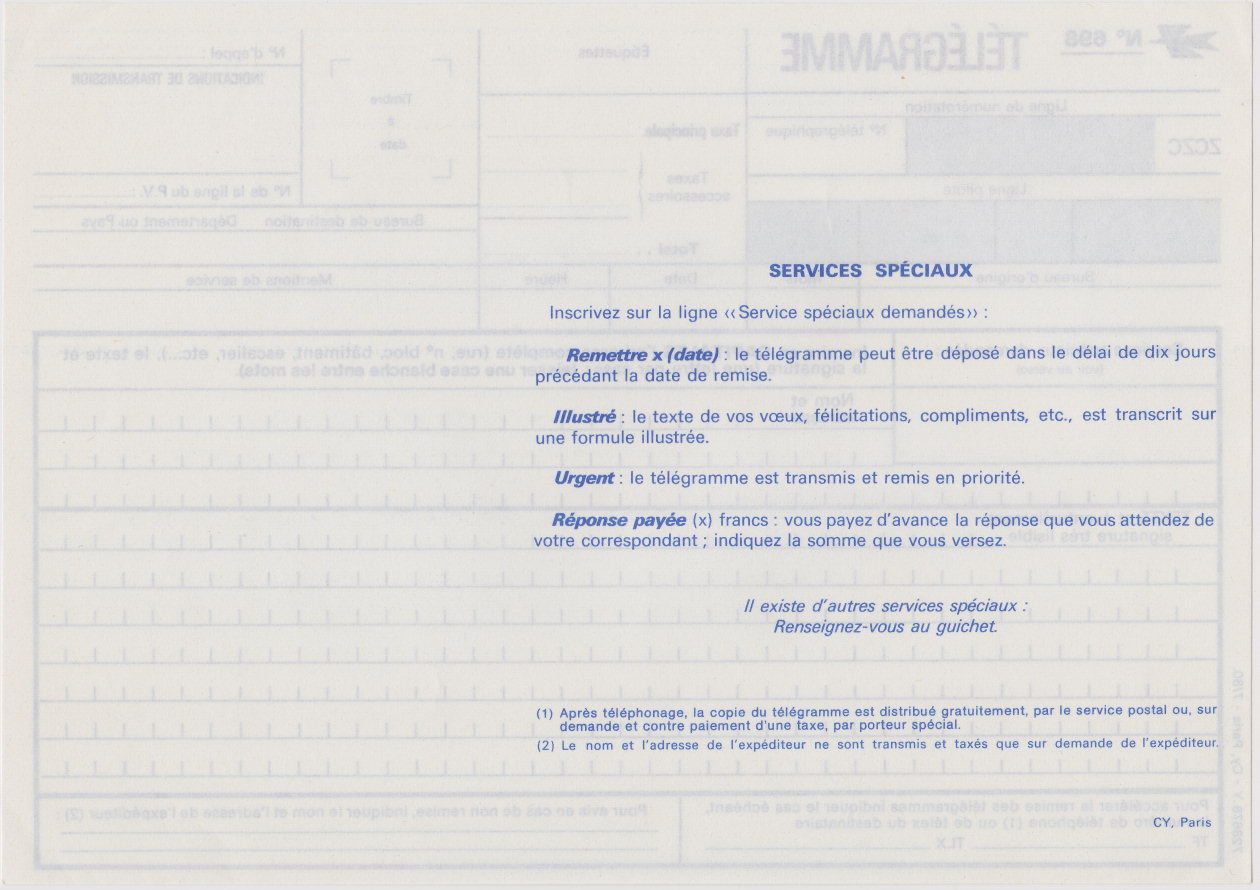
This also looks like some kind of sending form, marked "No 700"
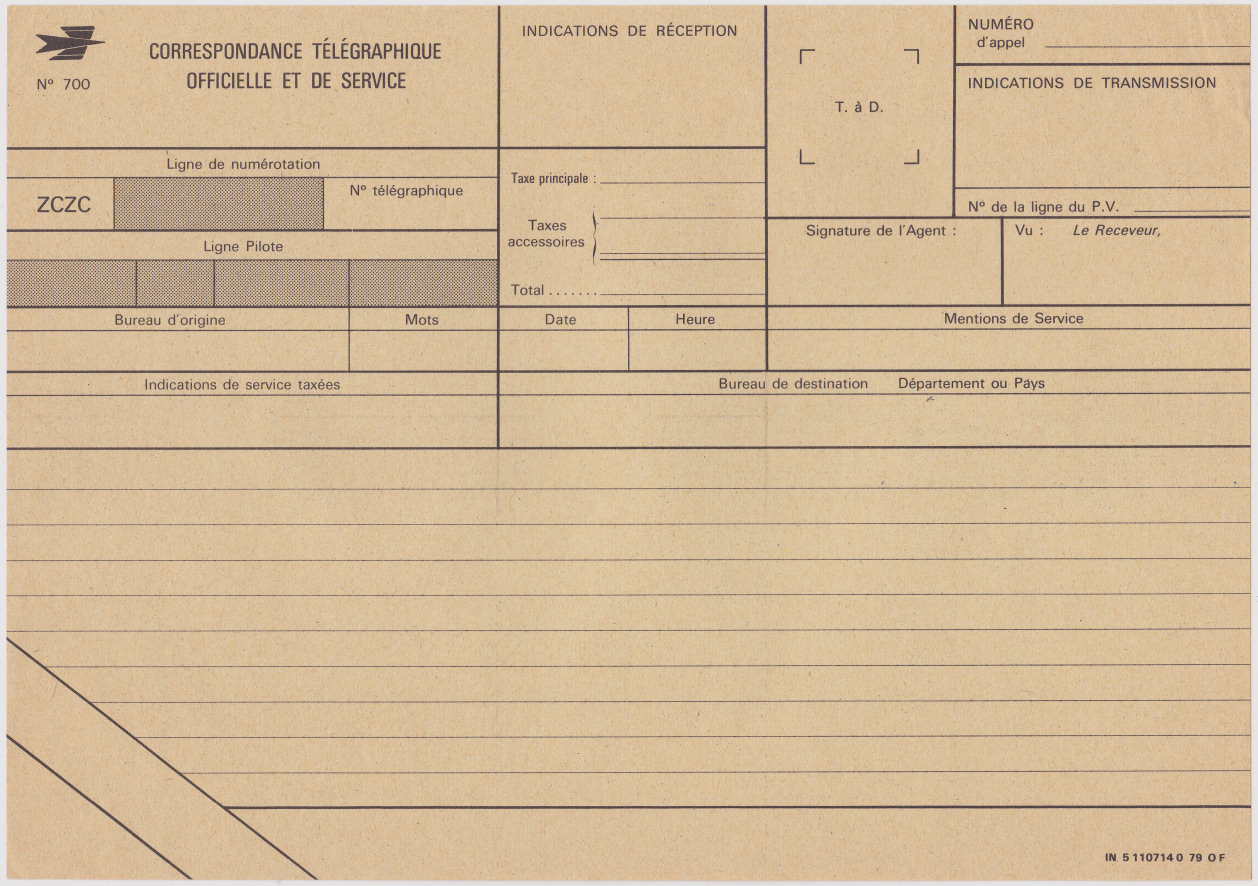
At the bottom-right is "IN 5 1107140 79 OF ". Nothing on the back.
Front and back of some kind of receipt, marked "No 708"
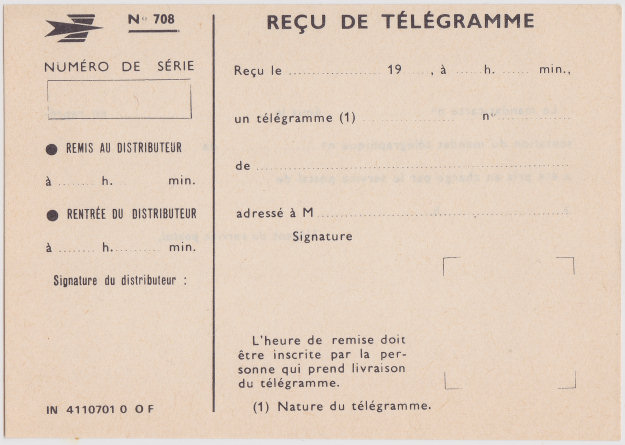
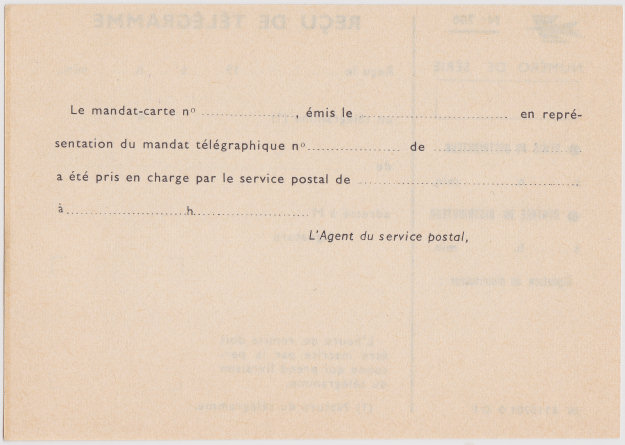
At the bottom-left of the front is "IN 4110701 0 OF ".
A replacement Telegram form, marked "No 709"
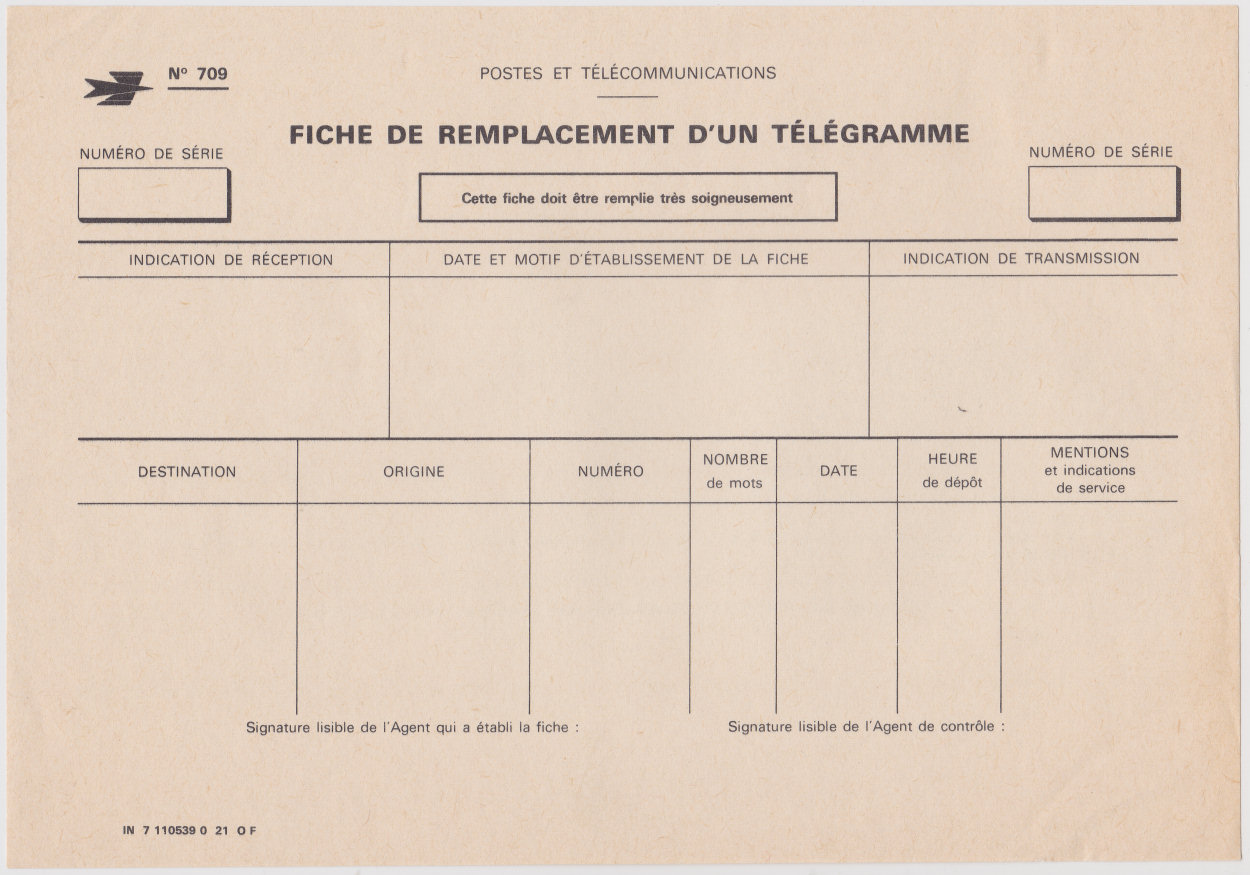
At the bottom-left is "IN 7 110539 0 21 OF ". Nothing on the back.
Refund of telegraphic fees - front and back of form "No 1374"
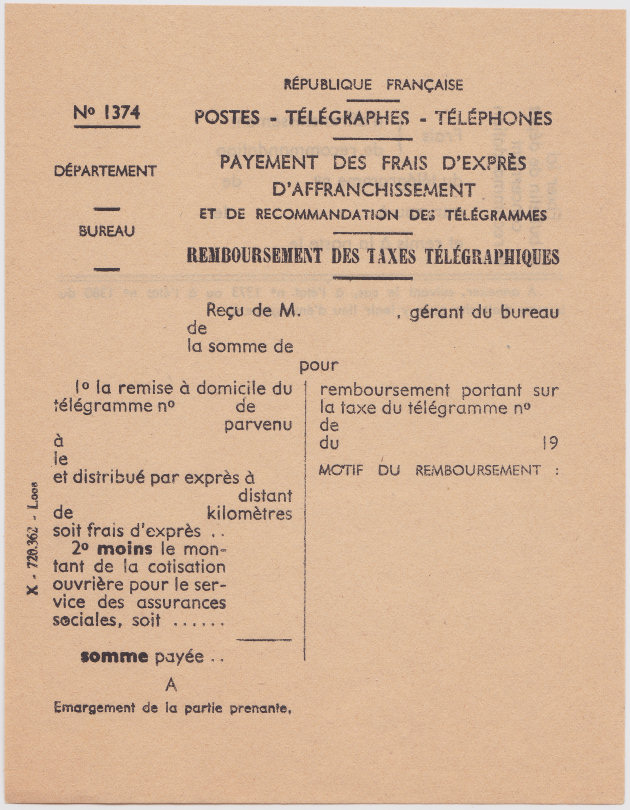
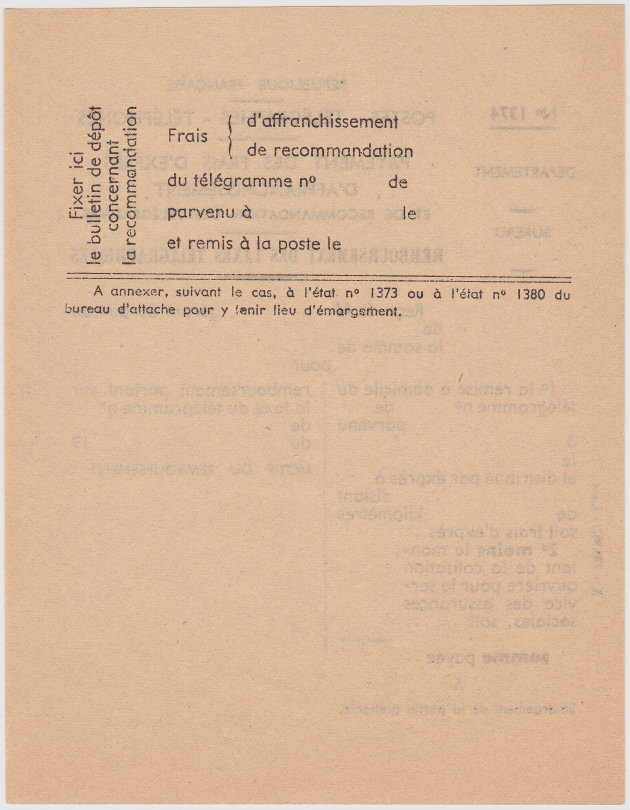
Up the bottom-left of the front is "X - 720.362 - Loos". Loos is in the region Nord-Pas-de-Calais
Outside and inside of an envelope, form "No 1392"
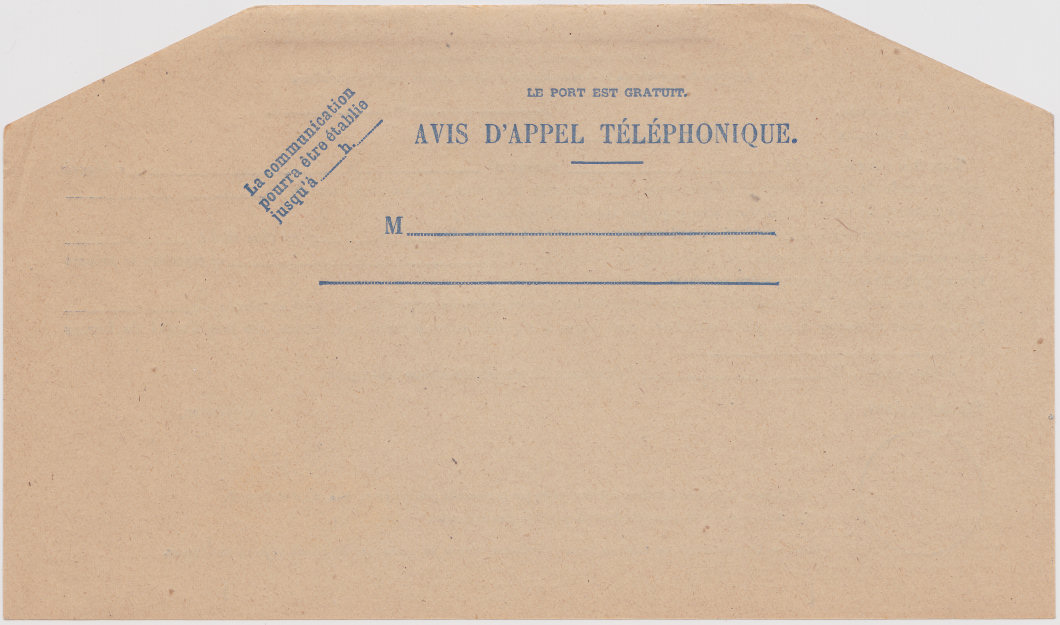
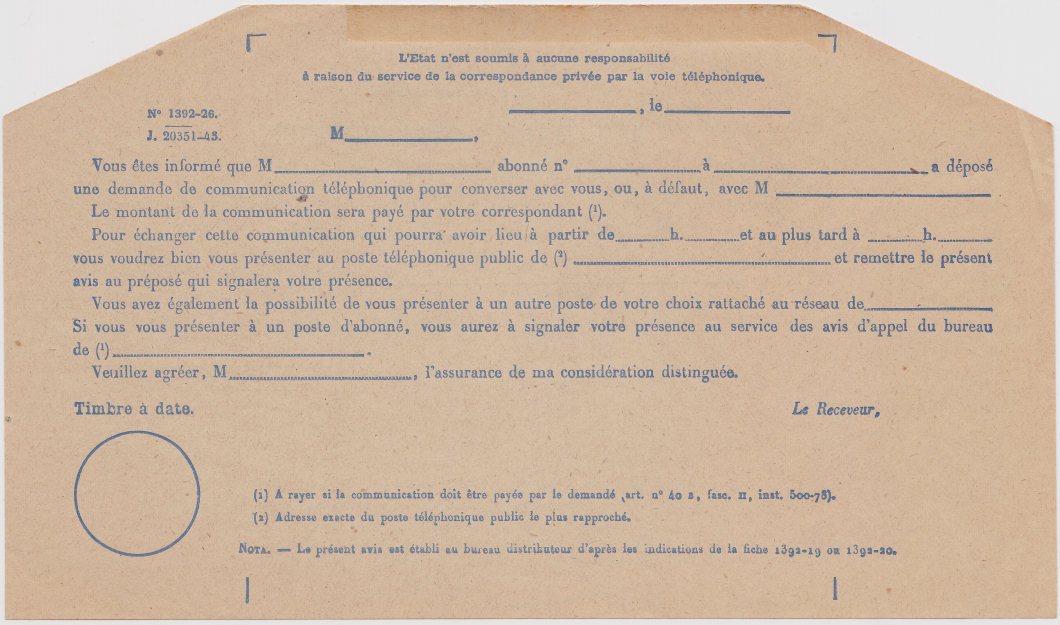
At the top-left of the inside is "No. 1392-26. " with "J. 20351_43." underneath.
At the bottom is : "Note. — This notice is drawn up at the distributor's office according to the indications of the sheet 1392-19 or 1392-20."
For Money transfer ? - front and back of form "No 1403"
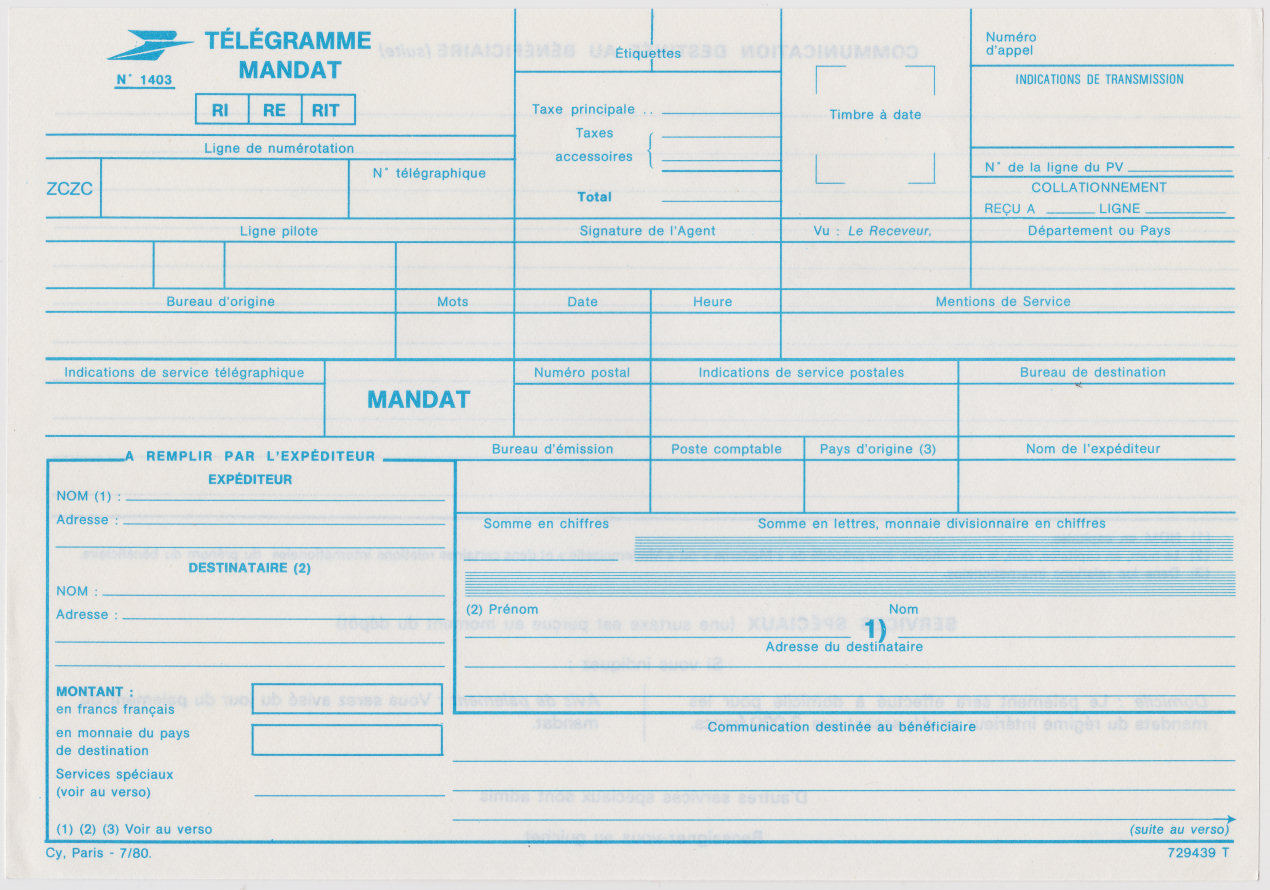
At the bottom of the front there is "Cy, Paris - 7/80" and on the right is "729439 T".
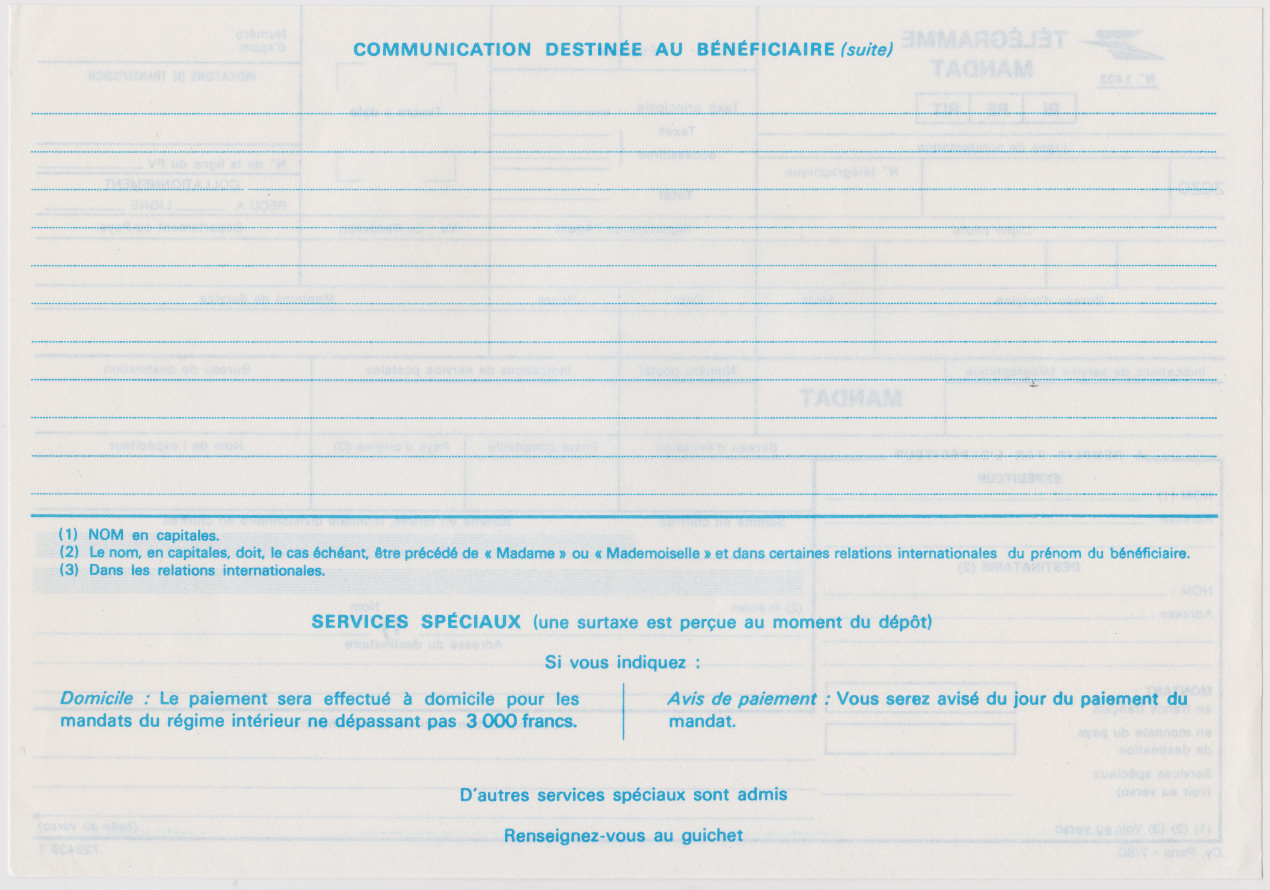
At the bottom-left there is a limit of 3,000 francs on payments. "Renseignez-vous au guichet" at the bottom means "Inquire at the ticket counter".
Another for Money transfer ? - front and back of a different form "No 1403"
This is a different colour and has quite a few other differences in the form as well as the number at the bottom being different.
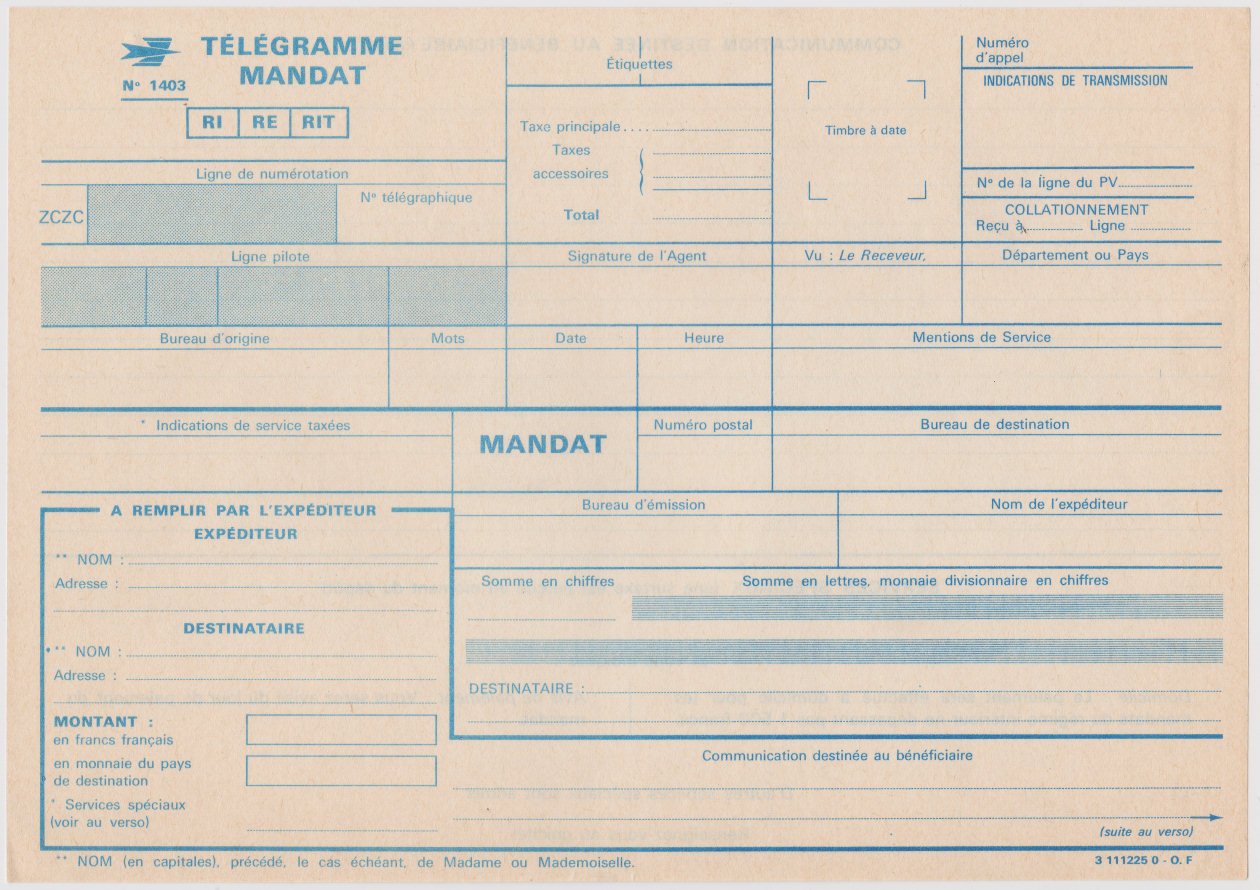
At the bottom-right of the front there is "3 111225 0 - O. F ".
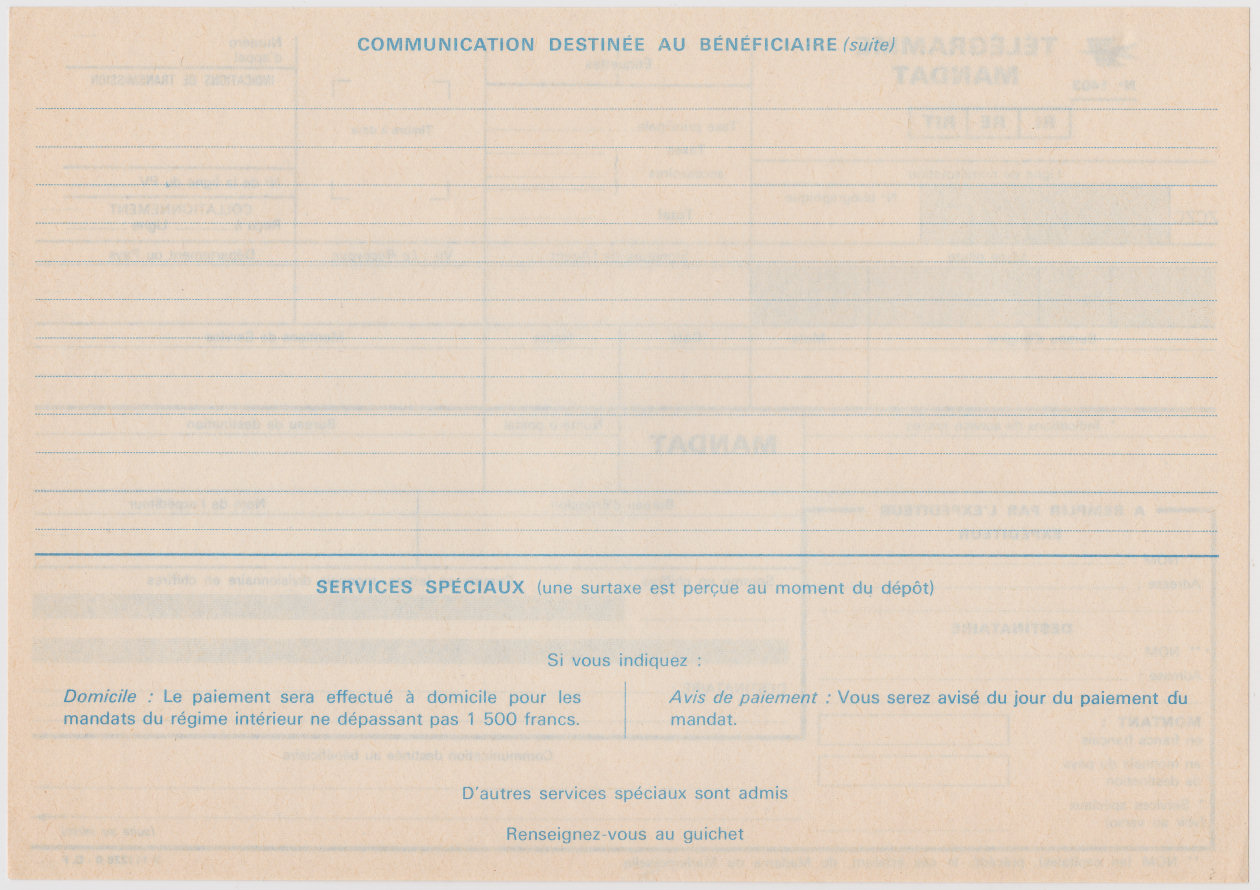
The bottom-left of this has a limit of 1,500 francs on payments. ".
Steve Hiscocks wrote:
These stamps were issued without gum and their exact means of use remains something of a mystery. Examination of the backs of some 30 used
copies shows that a few were attached to paper with a dab of glue while others were apparently pinned to paper. Most however seem not to have
been attached in any way and a few of these are also cancelled on the back either with a pen scribble or with the same circular date stamp (cds) as was
used on the face. I have not seen used copies on piece.
All used copies I have seen have been cancelled with neat and usually legible cds. They are also found undifferentiated with various Algerian date
stamps and French dealers tend to charge more for these. Dates up to November 1910 seem quite common on the 1906 issues used in Algeria
but I have not seen any dated in 1911 or beyond. The use of telephone stamps in France was discontinued on 1 January 1910.
One also finds quite commonly, cut-outs of the 'Chaplain' design for 50c and other values, bearing the word 'TELEGRAPHE' as on the earlier
telephone stamps, in black on blue paper, etc. They are often perforated 10½ top and right hand side, have no outer frame line and are cancelled
with typical telegraph cancellations in red, blue, or black. The status of these is unclear but, since they usually have partial writing on the reverse
they would seem to derive from some sort of telegraph or telephone form.
My note:
Sometimes cancelled by pen, cut-off corners or punch-holes (sometimes in combination).
1880 - Typographed on thin manila paper. No watermark or gum.
Imperf. all round but perforated between label and counterfoil. Control numbers in black.
This illustration is of Type 1, taken from Hiscocks book, page 115.
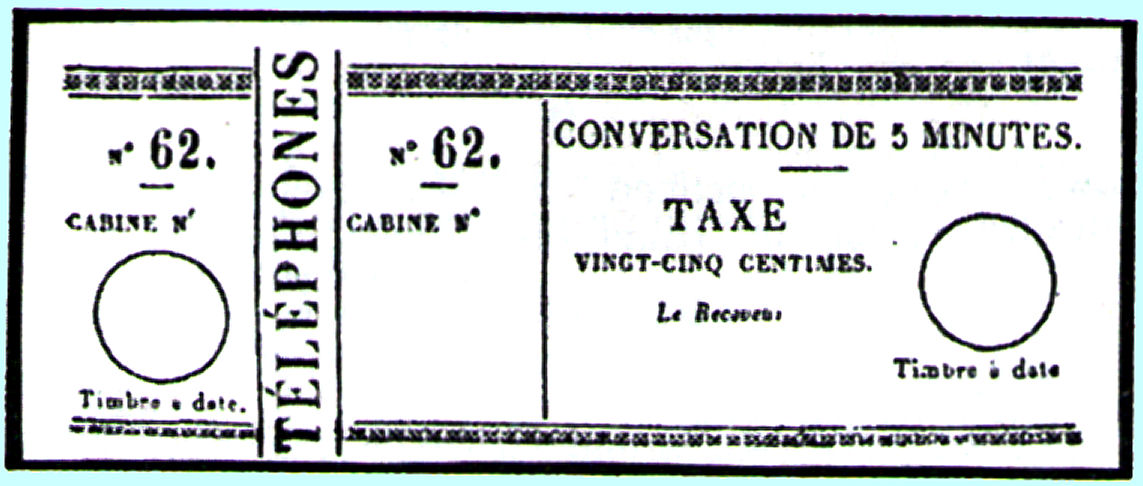

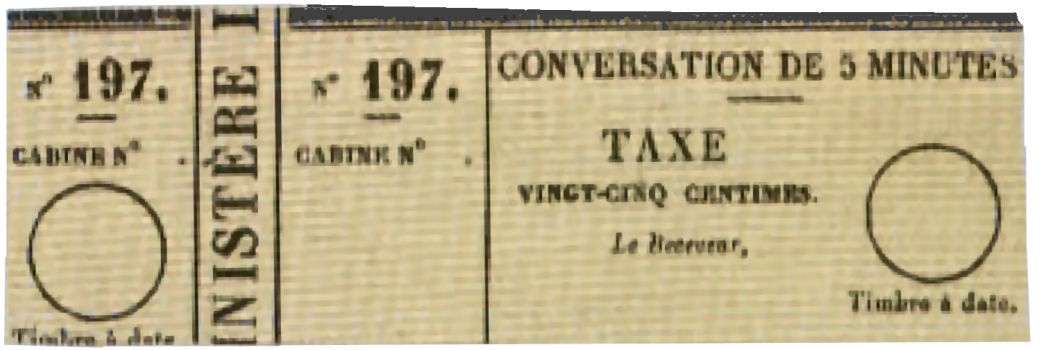
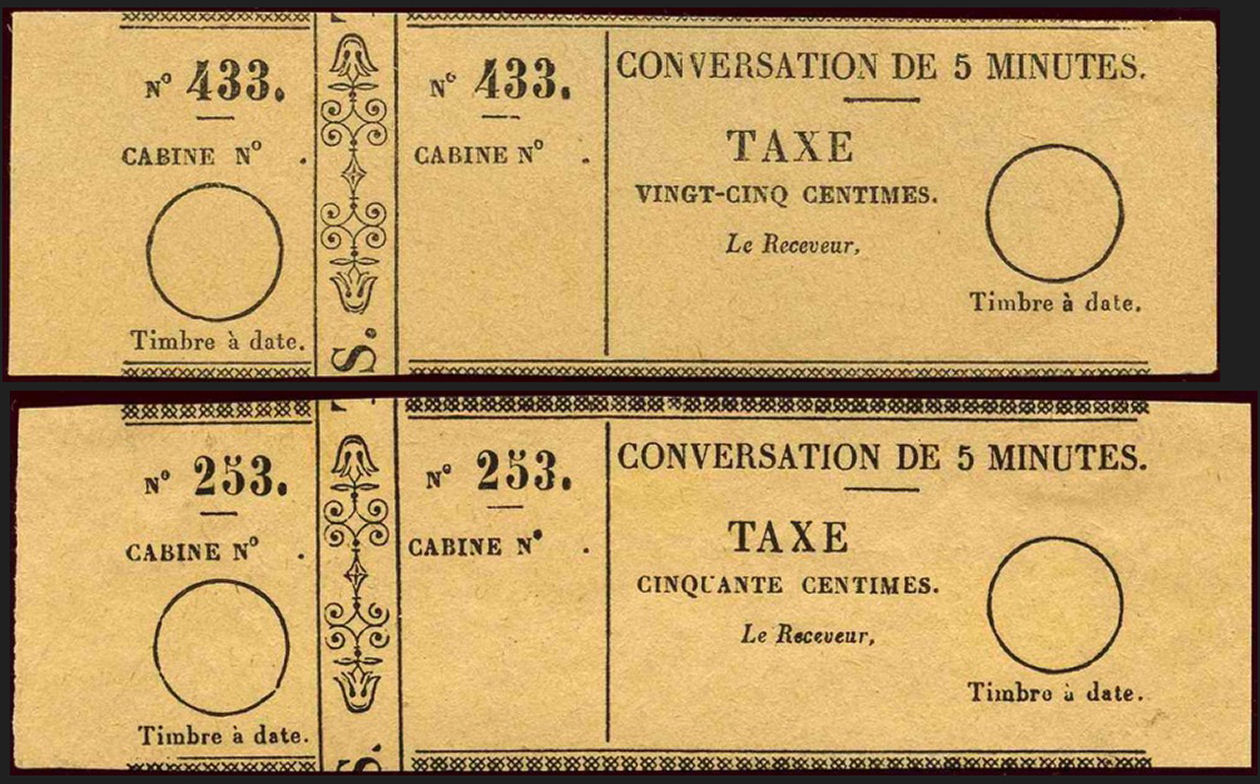
The bottom pair shows the 25c and 50c courtesy of Patrice Robin.
The 50c numbered 364 is courtesy of Spink and Son.
The variations of these images suggest that these were printed in vertical strips with wording between the main part and the receipt.
The wording would seem to contain MINISTÉRE DE TÉLÉGRAPHES, TÉLÉPHONES at least with a pattern.
| Hisc. | Type. | Description | Mint | Used |
|---|---|---|---|---|
| H1 | 1 | 25c black / buff manila | 1200.00 | - |
| H2 | 1 | 50c black / buff manila | 1200.00 | - |
1885 - 1887 - Lithographed on thick stiff paper having the 'words'
....MINISTEREDESPOSTESETÉLÉGRAPHESTÉLÉPHONES ... continuously in white on pale colour (in brackets below).
No watermark or gum. Perf. 13½.
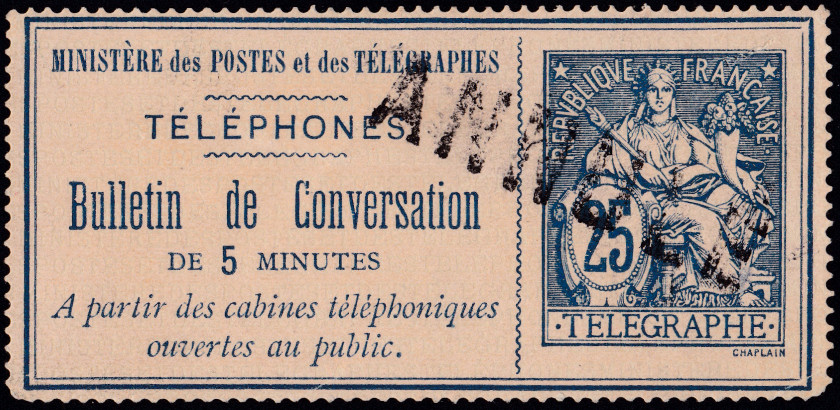
This shows the 25c (H3) with an unusual 'ANNULE' cancel.
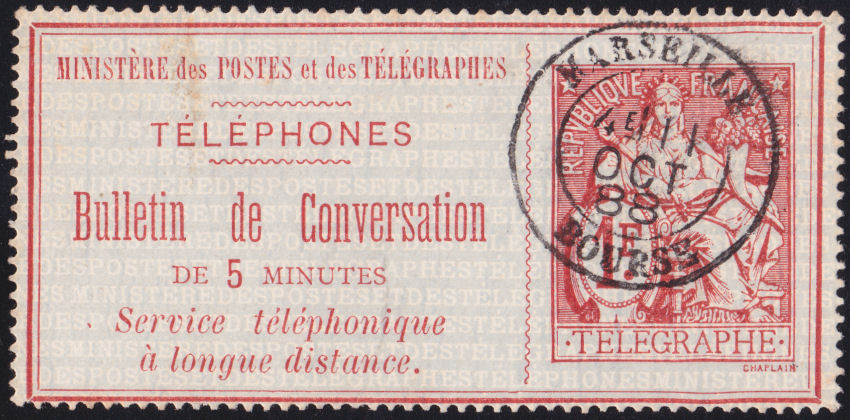
H5 - 1Fr
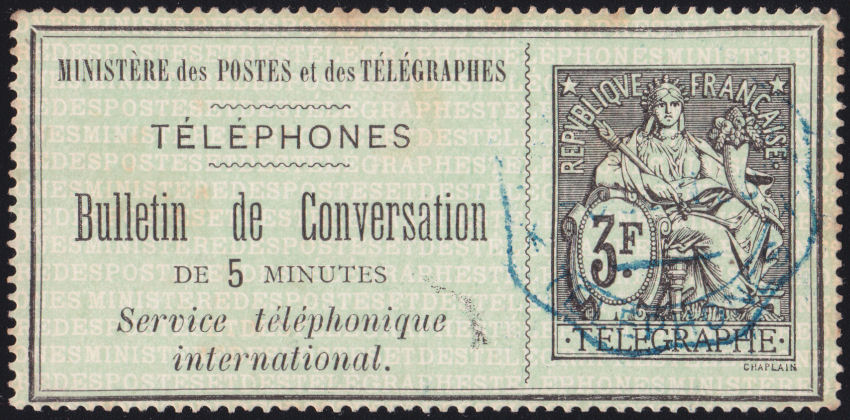
H6 - 3Fr
| Hisc. | Type. | Description | Mint | Used |
|---|---|---|---|---|
| H3 | 2 | 25c deep dull blue / (yellow-buff) | 240.00 | 10.00 |
| H4 | 2 | 50c red / (pale pink) | 240.00 | 15.00 |
| H5 | 2 | 1F red / (pale blue) | 320.00 | 18.00 |
| H6 | 2 | 3F black / (pale green) | 400.00 | 35.00 |
Note: The back of the 25c is green, the backs of the 1F and 3F are white.
Hiscocks added the following note:
| Note. Nos. 3 and 4 were for use with public telephones for local calls. No. 5 for long distance calls and No. 6 for international calls. |
1888 - 1896 - As above but security background wording altered to
....POSTESETTÉLÉGRAPHESTÉLÉPHONES ... continuously and
the upper wording on the tab altered from "Ministere des Postes et des Télégraphes" to
"Postes et Télégraphes-Téléphones, etc.
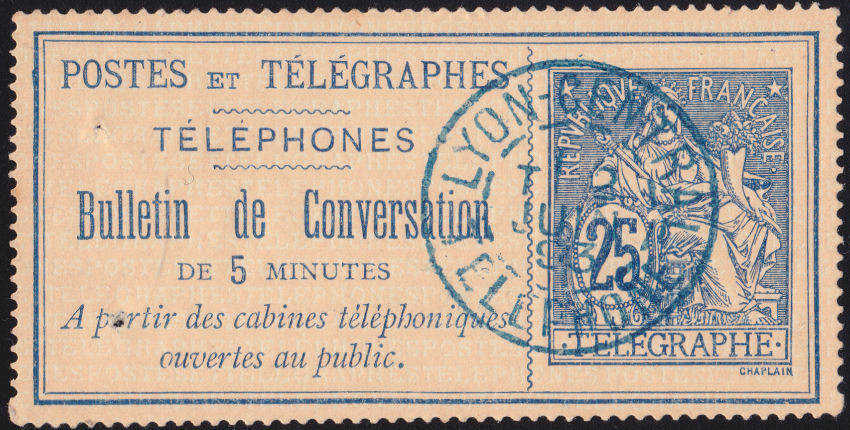
H7 - 25c
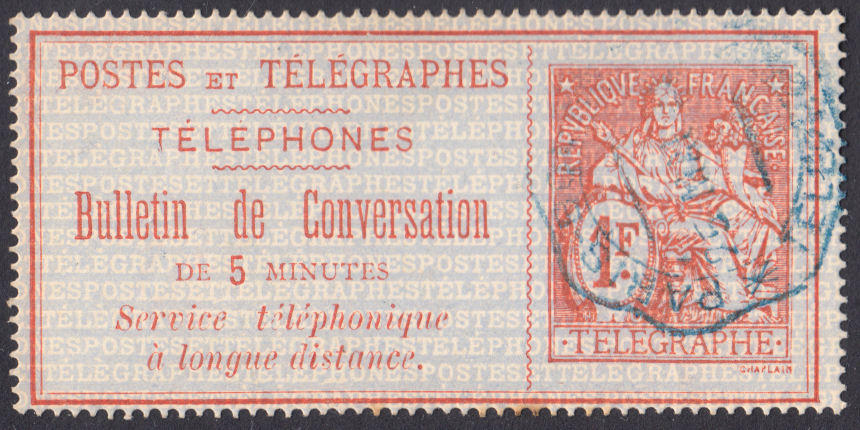
H9 - 1Fr
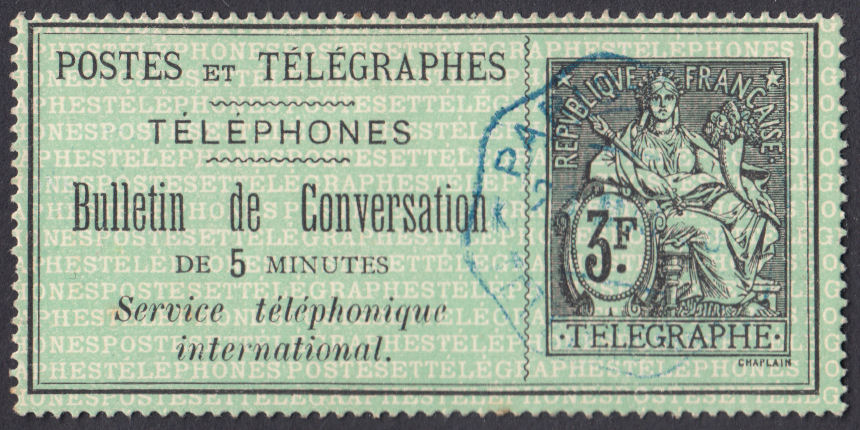
H10 - 3Fr
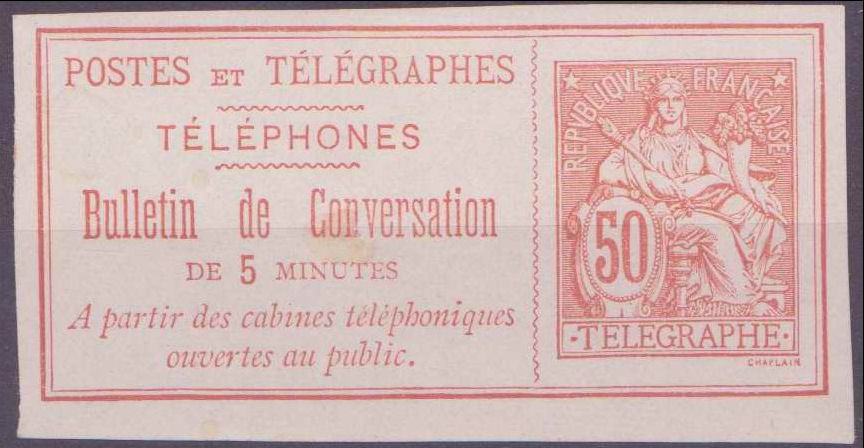
*This shows an imperf. 50c courtesy of Patrice Robin. (proof ? Added as H8d)
| Hisc. | Type. | Description | Mint | Used |
|---|---|---|---|---|
| H7 | 3 | 25c dark blue / yellow-buff | 200.00 | 16.00 |
| H8 | 3 | 50c red / pale pink | 120.00 | 12.00 |
| *H8a | 3 | Security background missing | 135.00 | - |
| *H8b | 3 | Imperf. | 200.00 | - |
| *H8c | 3 | Imperf. Black on pale pink | 220.00 | - |
| *H8d | 3 | Imperf. version of H8a | - | - |
| H9 | 3 | 1F scarlet / pale blue | 120.00 | 12.00 |
| H10 | 3 | 3F black / palish green | 200.00 | 16.00 |
* H8a to H8c are added due to entries in the Yvert et Tellier catalogue.
Note: The back of the 25c is green, the back of the 50c has a 'granite' effect with blue fibres. The backs of the 1F and 3F are white.
Hiscocks added the following 2 notes:
| Note 1. Uses were as in the Note below No. 6 and the wording at the bottom of each tab indicates its purpose. |
| Note 2. The reverse of my copy of No. 3 is dull green while, from behind, both No. 4 and No. 8 appear to be on granite paper (i.e. having a surface layer of blue fibres). |
1888 - 1896 - As above but inscribed "SERVICE TÉLÉPHONIQUE DE NUIT INTERURBAIN"
in places of "TELEPHONES".
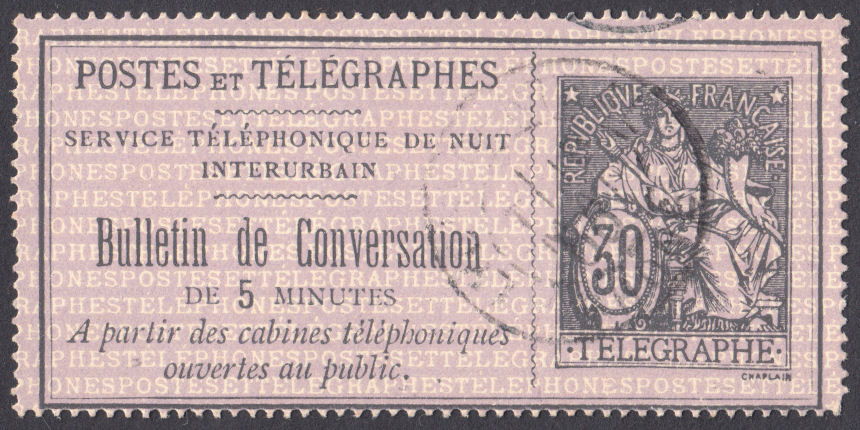
Type 3 - H11 - 30c
| Hisc. | Type. | Description | Mint | Used |
|---|---|---|---|---|
| H11 | 3 | 30c black / pale lilac | 120.00 | 12.00 |
| H12 | 3 | 30c green / pale grey | 160.00 | 24.00 |
1888 - 1896 - As above (types 2 and 3) but overprinted as shown.
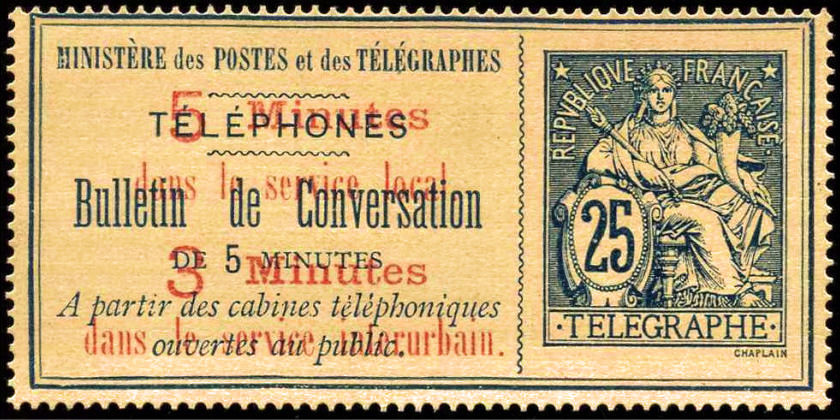
H13 courtesy of Patrice Robin.
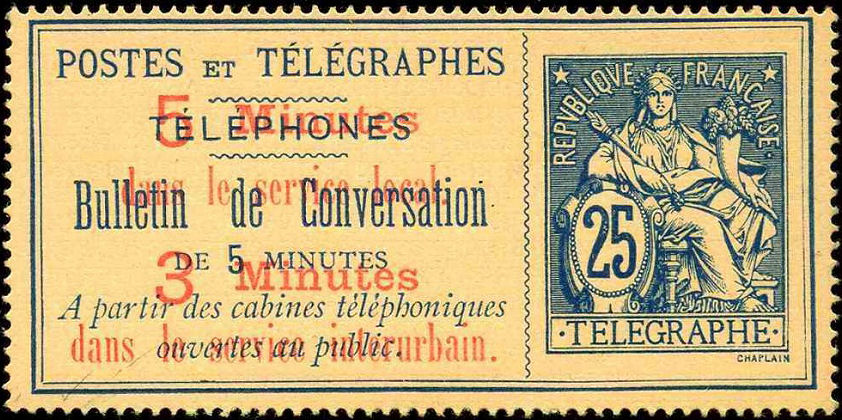
H14
courtesy of Patrice Robin.
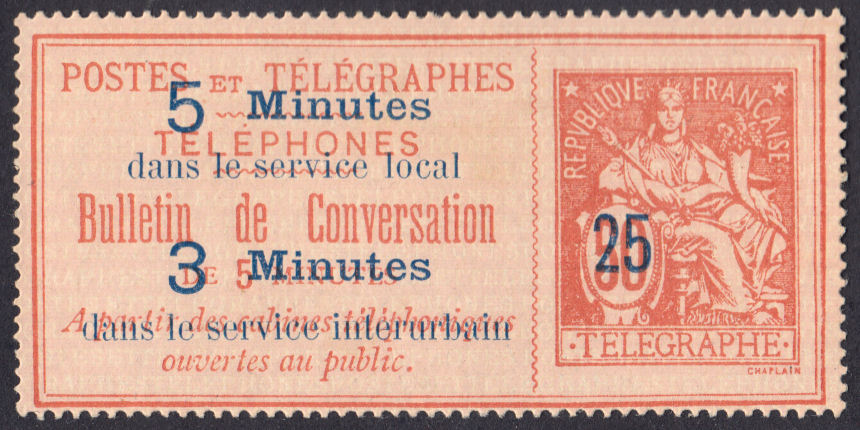
H15 - 25c on 50c.
| Hisc. | Type. | Description | Mint | Used |
|---|---|---|---|---|
| H13 | on H3 | 25c deep dull blue / yellow-buff (R) | 1600.00 | 400.00 |
| H14 | on H7 | 25c dark blue / yellow-buff (R) | 240.00 | 80.00 |
| H15 | on H8 | 25c on 50c red / pale pink (B) | 240.00 | 80.00 |
1896 - As No. 14 but "BULLETIN de CONVERSATION" in upper case.
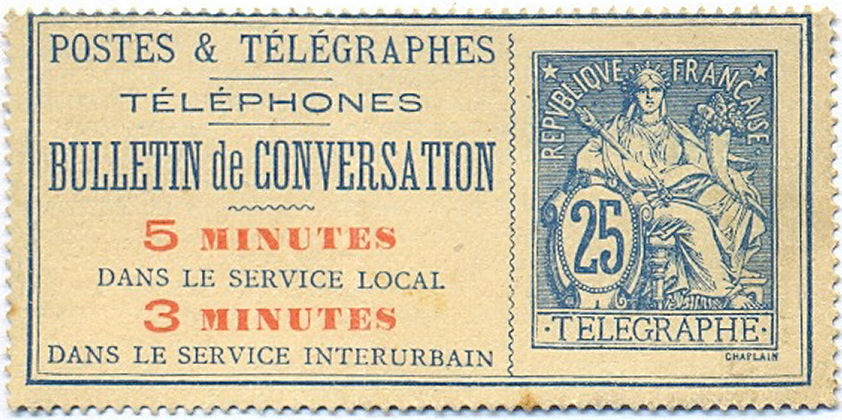
H16 courtesy of Frigga19.
| Hisc. | Type. | Description | Mint | Used |
|---|---|---|---|---|
| H16 | 3 | 25c blue and red / yellow-buff | 120.00 | 40.00 |
1897 - Similar to above but "TELEPHONES" substituted for "TELEGRAPHE" in the
tablet below the seated figure and omitted from the left hand section.
"Conversation" changed to "Communication", etc. Security background unchanged. Perf. 13½.
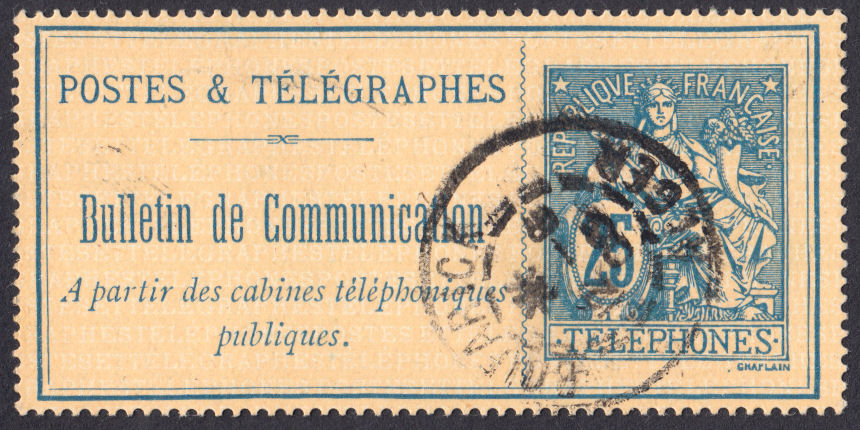
Type 5 - H17 - 25c - used in Boifarick (now Boufarik ?), Algeria
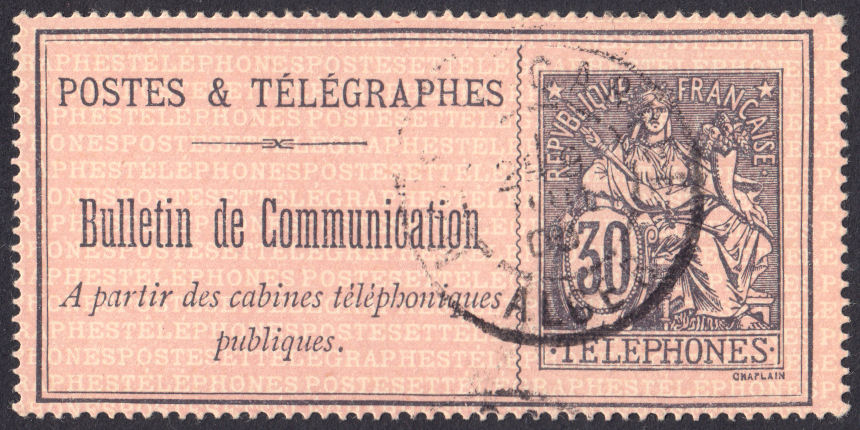
Type 5 - H18 - 30c - used in Mascara, Algeria
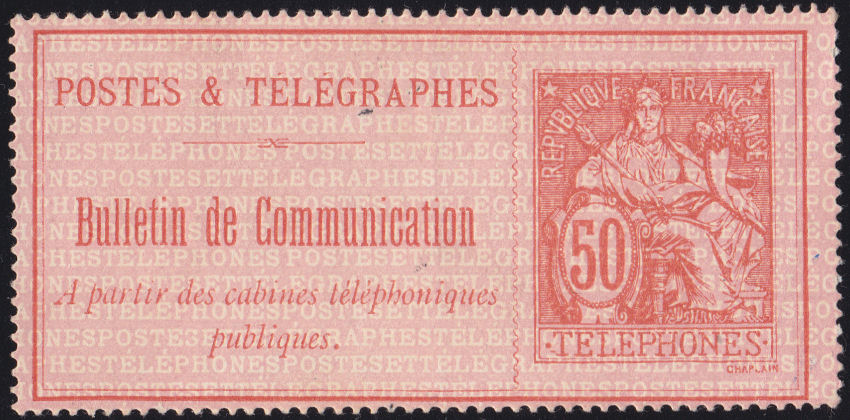
Type 5 - H19 - 50c
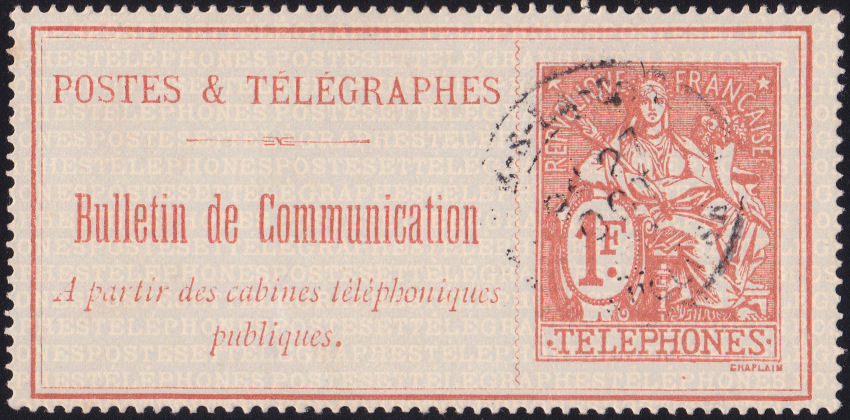
Type 5 - H20 - 1F
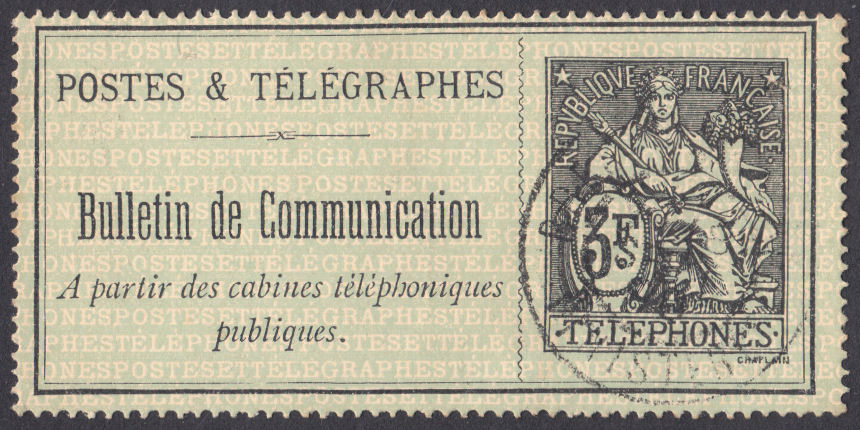
Type 5 - H21 - 3F
| Hisc. | Type. | Description | Mint | Used |
|---|---|---|---|---|
| H17 | 5 | 25c blue / cream | 60.00 | 8.00 |
| H17a | 5 | imperf. | 400.00 | - |
| H18 | 5 | 30c grey-brown / pale brownish pink | 100.00 | 20.00 |
| H19 | 5 | 50c red / pink | 80.00 | 8.00 |
| H20 | 5 | 1F scarlet / pale blue | 100.00 | 16.00 |
| H21 | 5 | 3F black / pale green | 400.00 | 80.00 |
| *H21a | 5 | imperf. | - | 113.00 |
* H21a is added due to an entry in the Yvert et Tellier catalogue.
Note: The back of the 25c is green, the back of the 50c has a 'granite' effect with blue fibres. The backs of the 1F and 3F are white.
1900 - As above (No. 17) surcharged "TAX RÉDUITE à 0,15 centimes" in red.
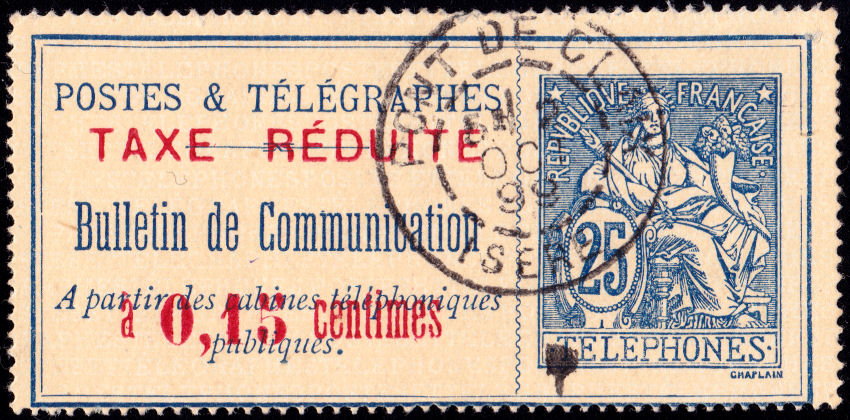
H22 15c on 25c
| Hisc. | Type. | Description | Mint | Used |
|---|---|---|---|---|
| H22 | 6 | 0.15 on 25c blue / pale yellow | 60.00 | 16.00 |
| H22a | 6 | surcharge double. | 210.00 | - |
| H22b | 6 | surcharge double (one inverted). | 210.00 | - |
| H22c | 6 | surcharge in black. | 155.00 | - |
These seem scarcer than Hiscocks prices would suggest.
Hiscocks added the following note:
| Note. Nos. 17 and 22 are again dull green on the reverse while No. 19 again has a layer of 'blue granite' on the reverse. |
1900 - 1906 As above but on plain white to cream thick wove paper.
No watermark. Perf. 13½
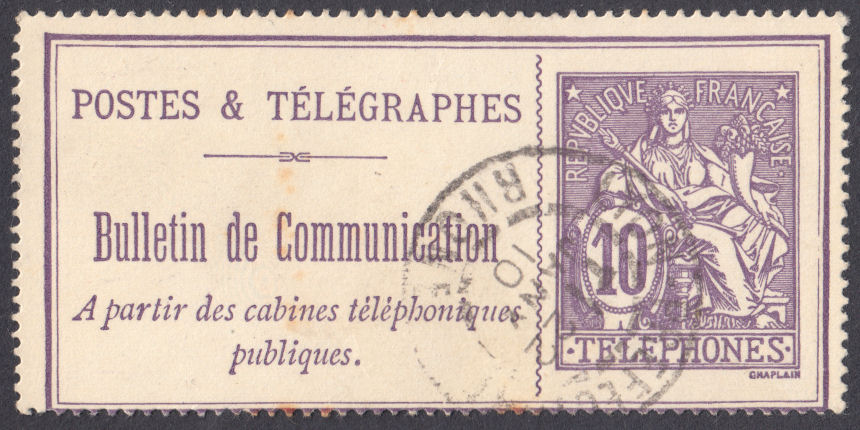
Type 7 - H23 - 10c
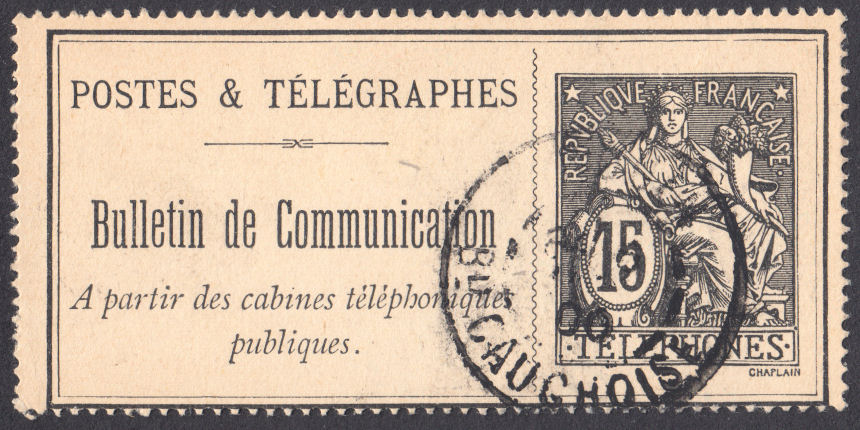
Type 7 - H24 - 15c
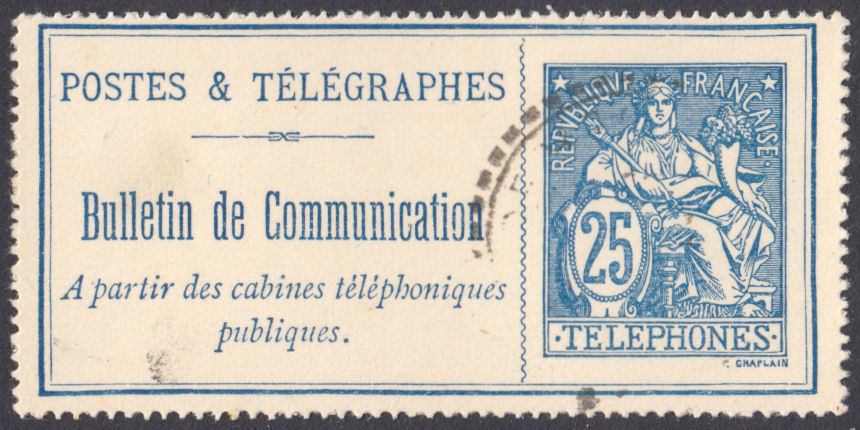
Type 7 - H25 - 25c
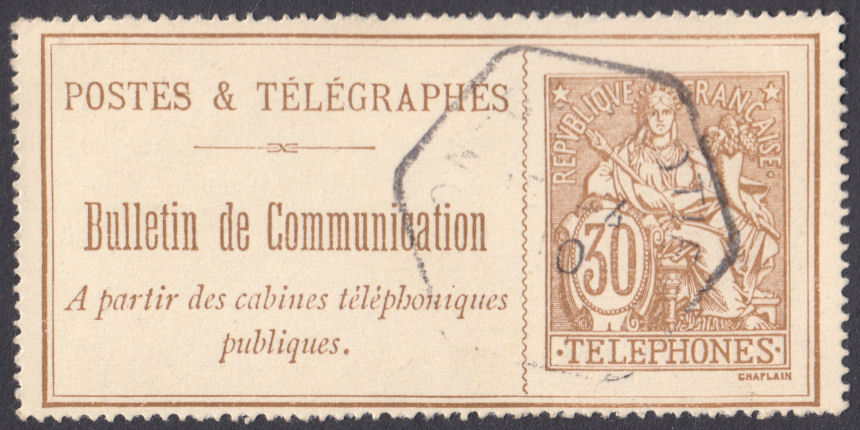
Type 7 - H26 - 30c
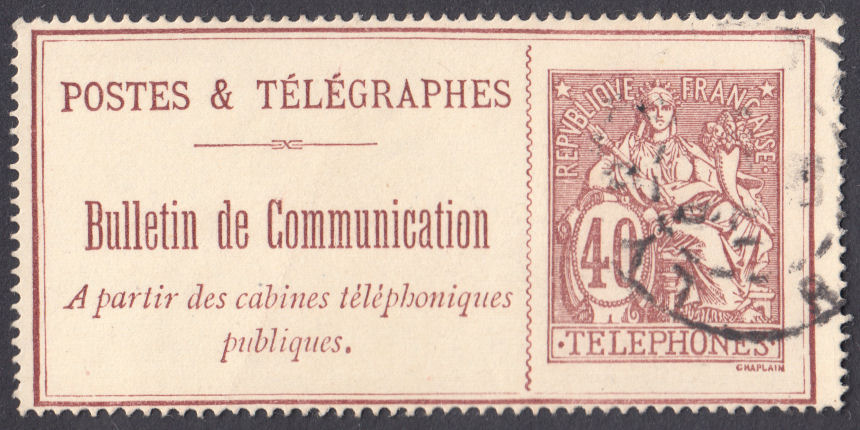
Type 7 - H27 - 40c
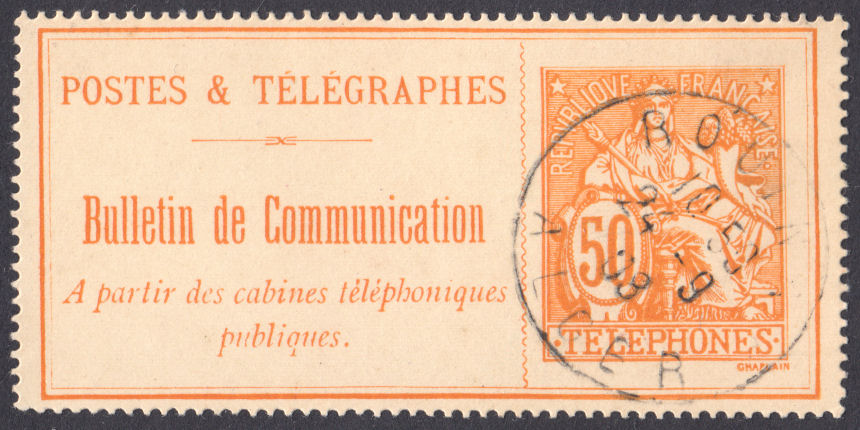
Type 7 - H28 - 50c - used in Rouiba(?), Algeria
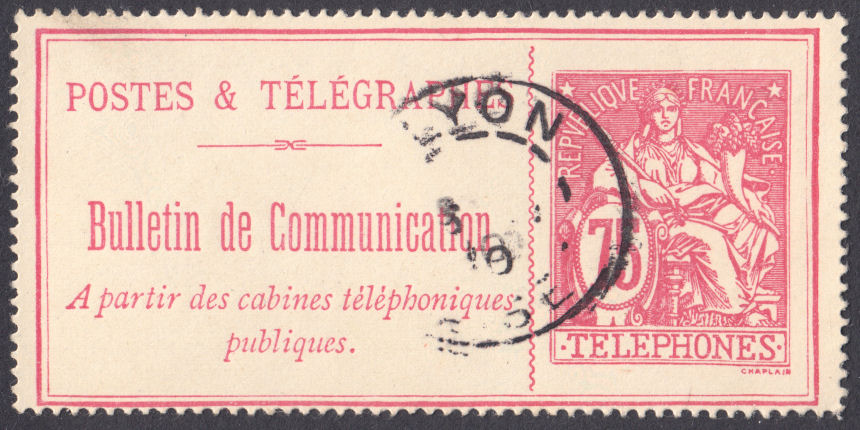
Type 7 - H29 - 75c
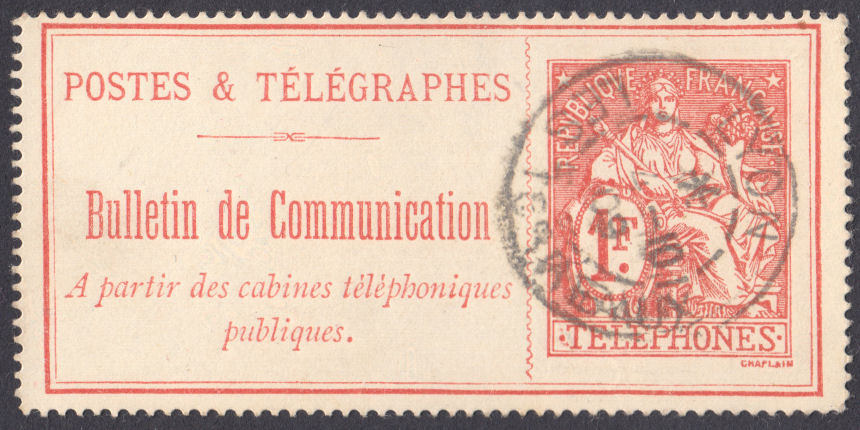
Type 7 - H30 - 1Fr.
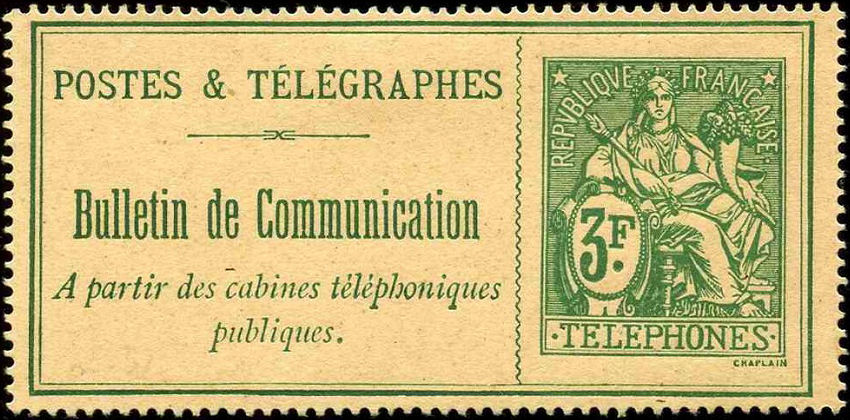
Type 7 - H31 courtesy of
Patrice Robin.
| Hisc. | Type. | Description | Mint | Used |
|---|---|---|---|---|
| H23 | 7 | 10c violet / pale cream (1906) | 45.00 | 3.00 |
| H23a | 7 | imperf. | 90.00 | - |
| H24 | 7 | 15c black / pale cream (1901) | 60.00 | 5.50 |
| H24a | 7 | imperf. | 150.00 | - |
| *H24b | 7 | double impression. | 230.00 | - |
| H25 | 7 | 25c blue / white to cream (1906) | 25.00 | 2.50 |
| H25a | 7 | imperf. | 90.00 | - |
| H26 | 7 | 30c yellow brown / cream (shades)(1906) | 60.00 | 6.50 |
| H26a | 7 | imperf. | 150.00 | - |
| H27 | 7 | 40c red brown / cream (shades)(1900) | 45.00 | 3.50 |
| H27a | 7 | imperf. | 75.00 | - |
| *H27b | 7 | double impression. | 230.00 | - |
| H28 | 7 | 50c bright orange/ cream (1906) | 35.00 | 3.50 |
| H28a | 7 | imperf. | 230.00 | - |
| H29 | 7 | 75c rose-red / pale cream (1900) | 90.00 | 12.50 |
| H30 | 7 | 1F brown red (shades) / pale cream (1906) | 75.00 | 13.00 |
| H31 | 7 | 3F green / pale cream (1906) | 4000.00 | 460.00 |
* H24b and H27b are added due to an entries in the Yvert et Tellier catalogue.
An internal Westminster Hotel Telephone Message of 1939.
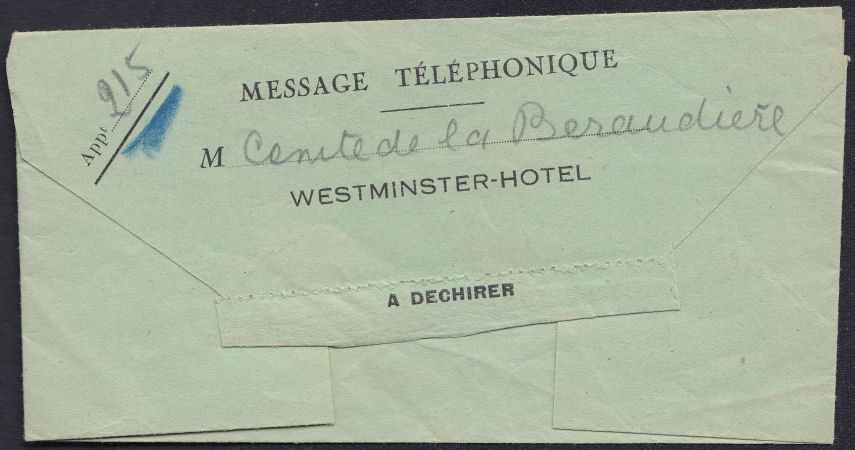
This design was also used on the Pneumatic Post in Paris.
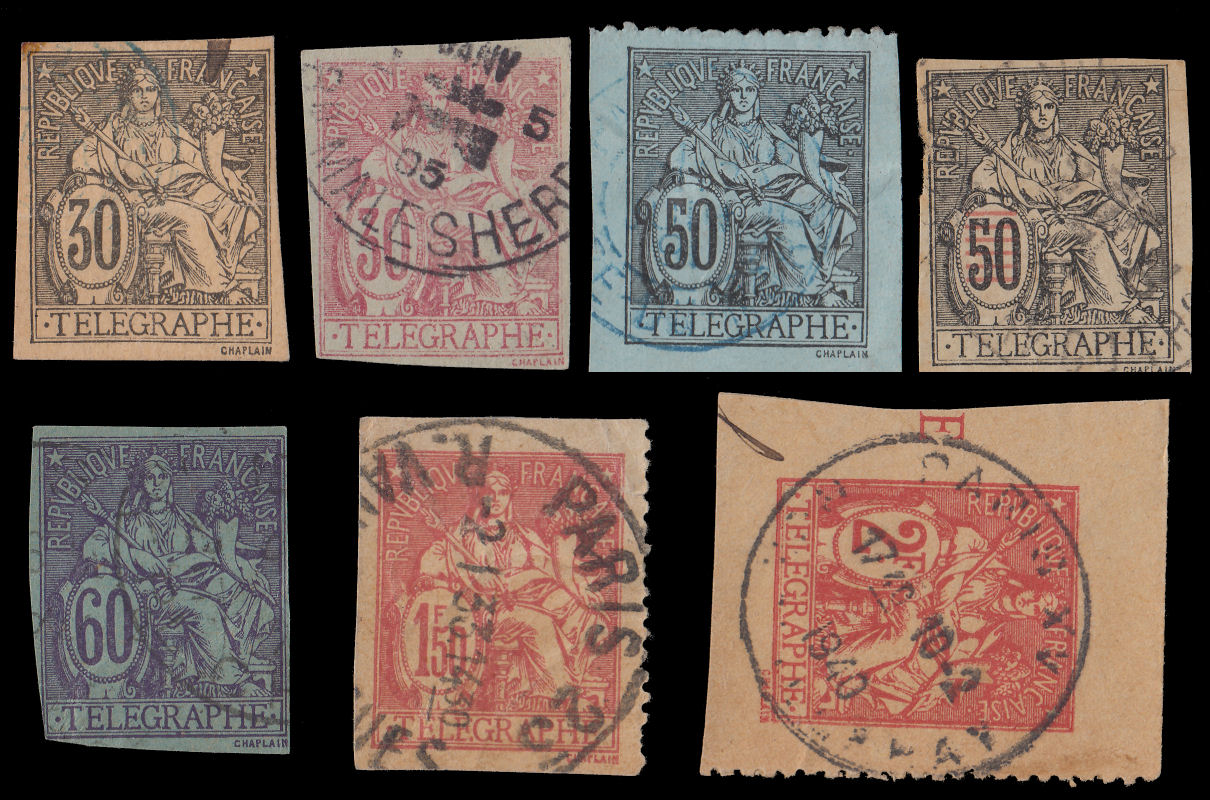
A range of denominations used.
Beginning in 1866, the pneumatic tube network of Paris was set up by the Telegraph Service for the purpose of express delivery
of received telegraph messages, thus they initially only delivered genuine telegrams.
The post and telegraph services were combined in 1878 and from the beginning of May 1879, the network was opened
up for public use
to speed delivery of ordinary mail.
Though there was nothing telegraphic about this additional mail, since the Telegraph section was providing the service,
the stationery used were marked 'Carte Télégramme' and the stamps inscribed 'TELEGRAPHE'.
As always, it is for the collector to decide what to collect.
The ones shown above are the Chaplain design, as can be seen inscribed at the bottom-left. It was planned to use this design for all of them,
but the die was not ready when the first issue of 1879 (1 May) was to be issued, so the existing "Sage" design
was used for the first 50c card (red stamp) and 75c (closed, black stamp) letter-card.
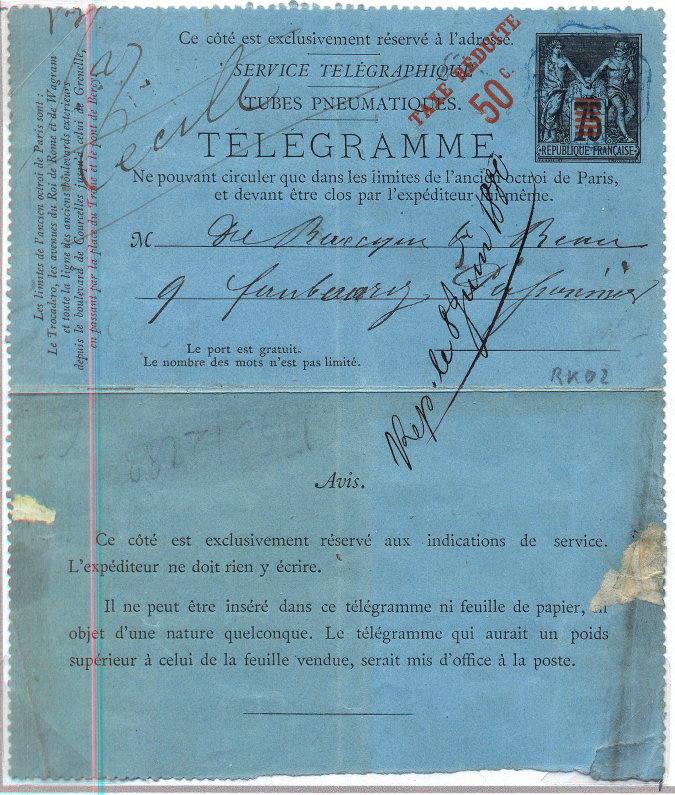
The first issues were a great success, due largely to the unlimited number of words that could be used. As a result the cost was reduced in 1880 to 30c and 50c respectively.
This is an example of the 1880 letter card, courtesy of RL. - ignore the vertical pink and blue stripes on the left, they're a scanning artifacts.
The original area covered by the system was detailed on the left of the card
The limits of the former Paris grant are:
The Trocadero, avenues of the King of Rome and Wagram
and the whole line of the old outer boulevards
from the Boulevard de Courcelles to that of Grenelle,
through Trône Place and the Bercy Bridge.
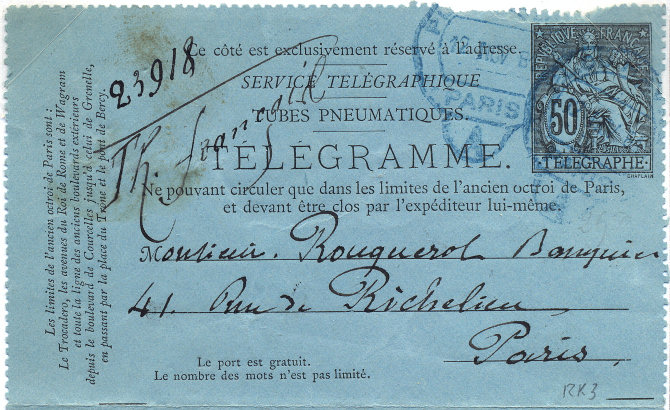
The front of a letter-card used 12 November 1881. - Courtesy of RL.
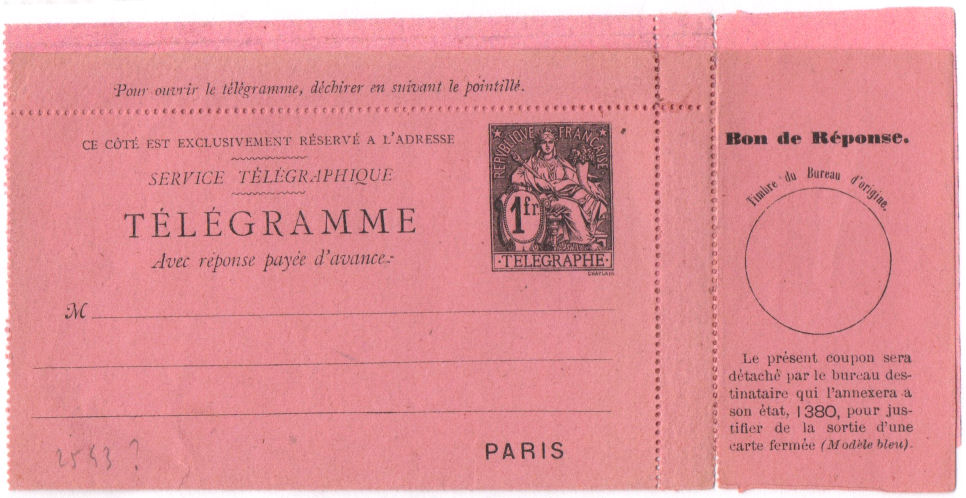
A 1F reply paid "Service Télégraphique" (end of 1879?) - courtesy of Les Bottomley.
Due also to the success, it had been decided to extend the pneumatic service in Paris in four stages and
subsequent cards showed maps indicating the area covered
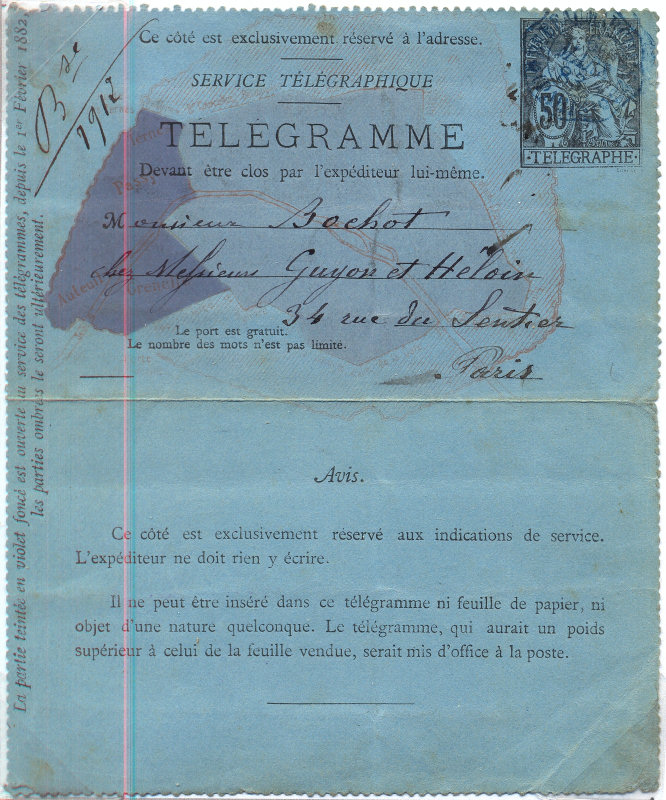
This says that the violet part is open for service from the first of February 1882, It is dated 6 March 1883 . - Courtesy of RL.
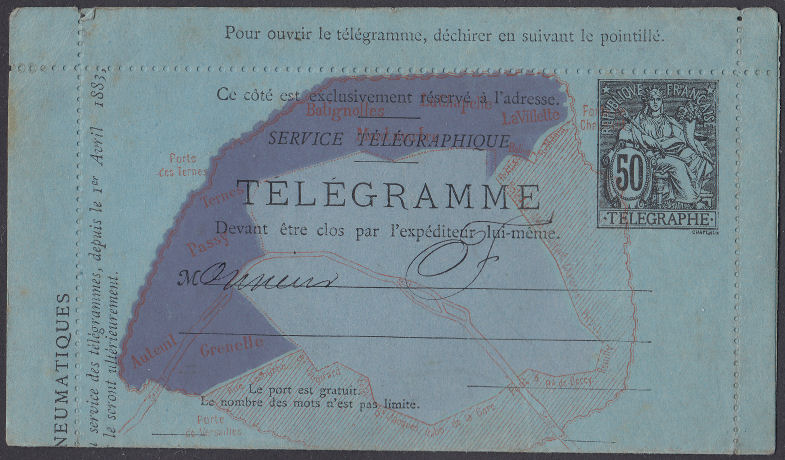
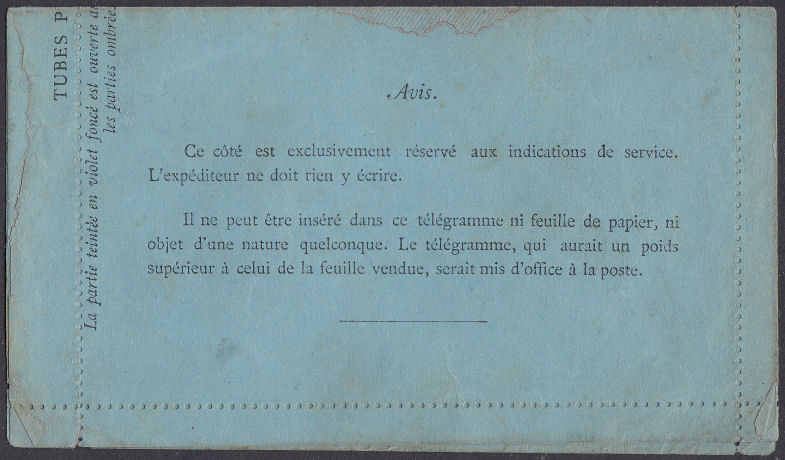
This says that the violet part is open for service from the first of April 1883, I have a used one dated 13 May 1884.
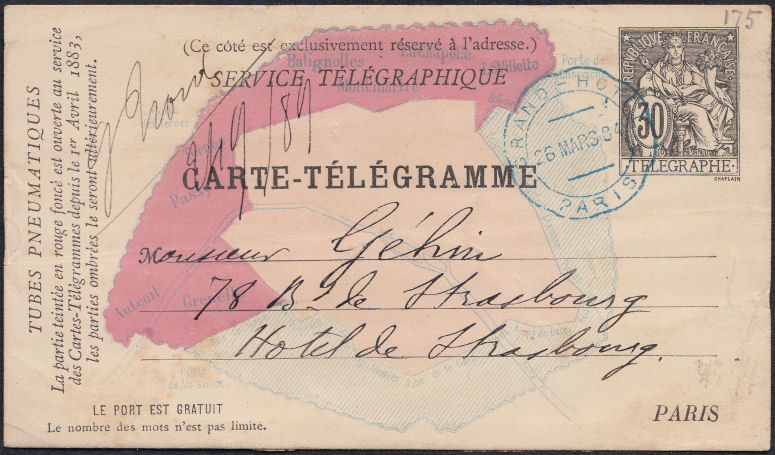
This says that the red part is open for service from the first of April 1883. It is used on 26 March 1884.
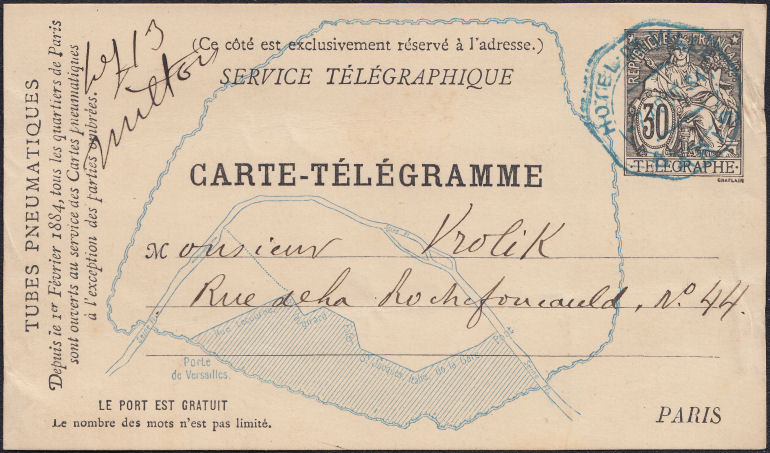
This says that from the first of February 1884, the whole of Paris is open for service except the shaded part.
"TUBES PNEUMATIQUES", Reduced cost.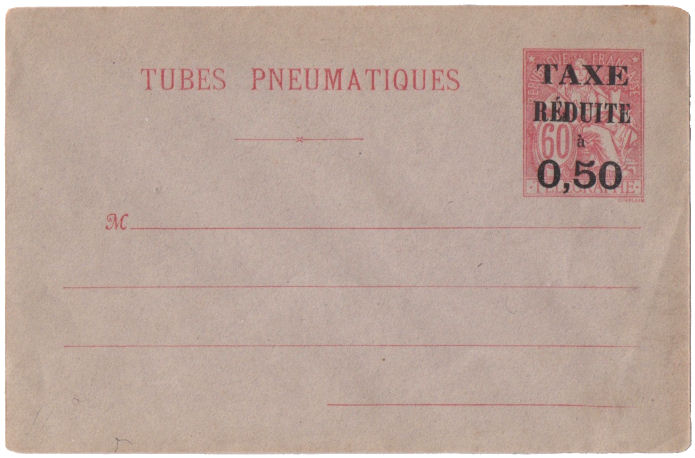
This TAXE RÉDUITE type dates from 1896 - image courtesy of Les Bottomley.
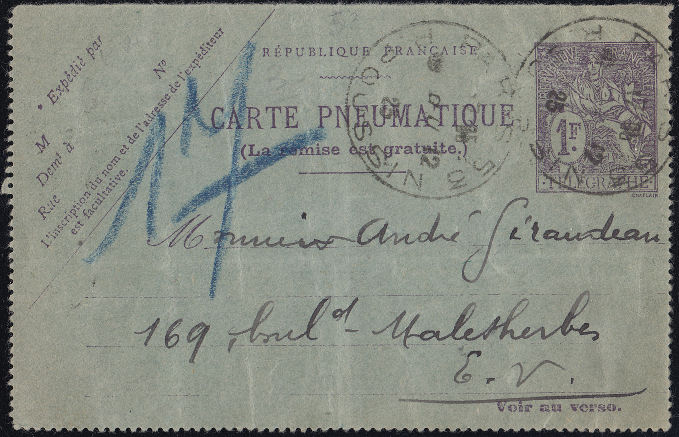
A 1F "Carte Pneumatique" of 1925.
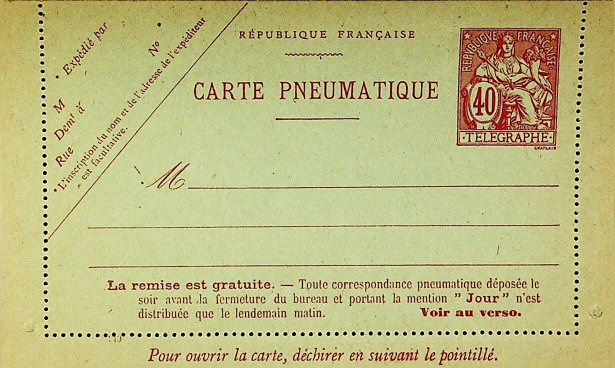
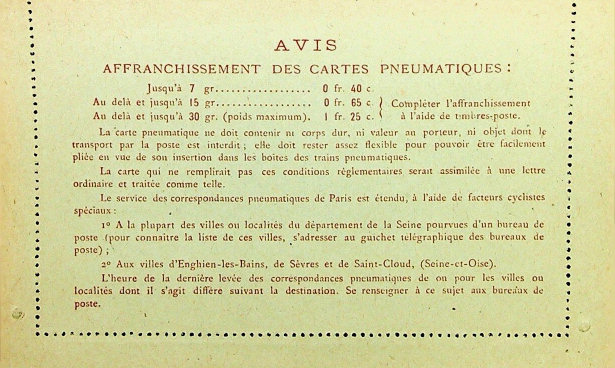
Images courtesy of AsianStamp - (click for listing).
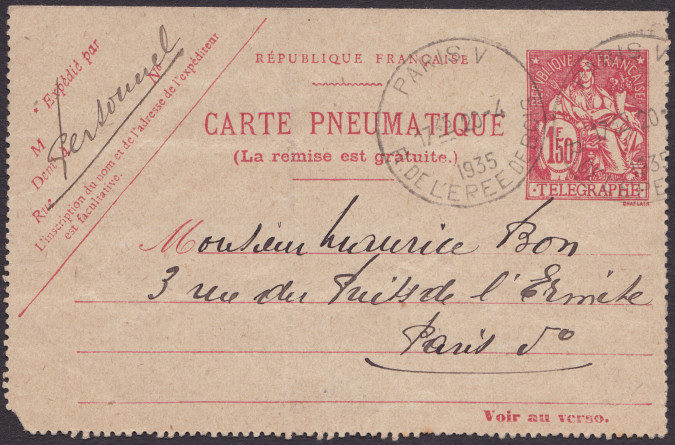
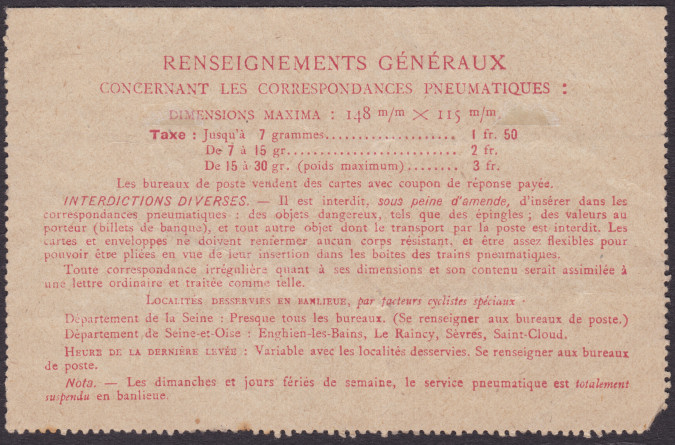
A similar 1F50 "Carte Pneumatique" of 1935, showing conditions on the back.
Both cards and envelopes were available, though with strict controls on any enclosures.
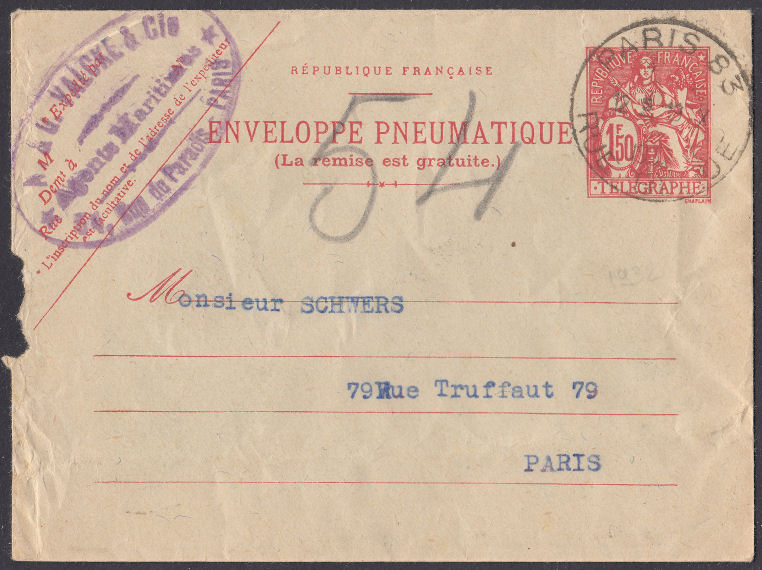
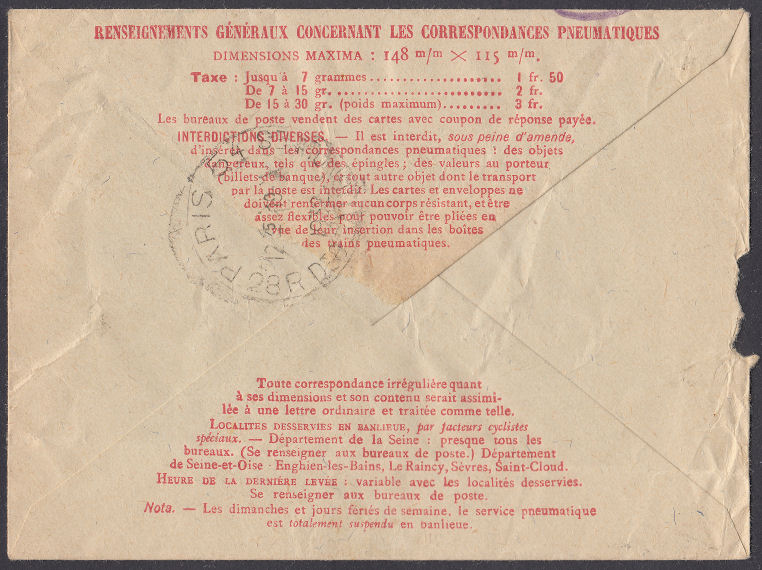
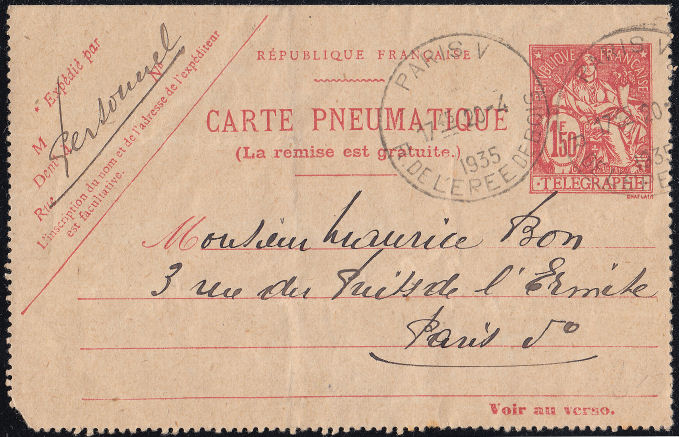
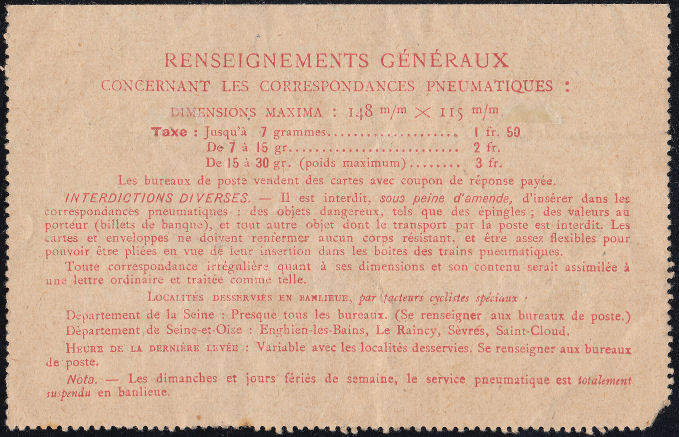
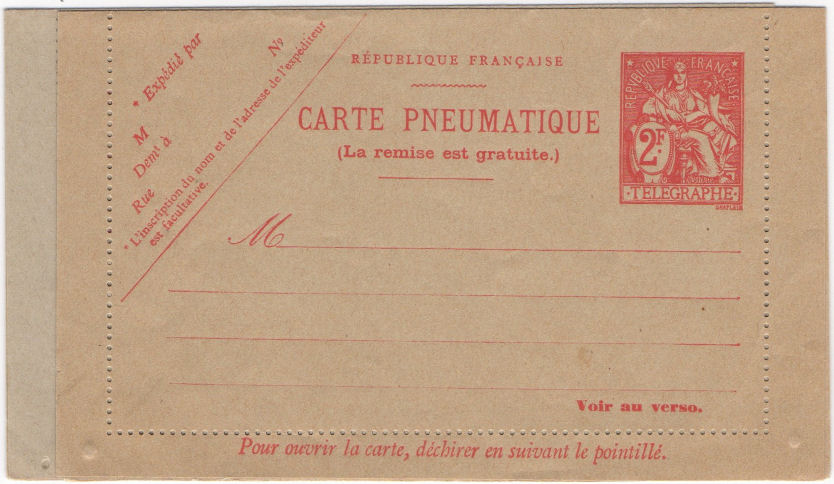
A 2Fr unused example - courtesy of Les Bottomley.
Further information about this network can be found in a three page account written by J.D. Hayhurst O.B.E. entitled The Pneumatic Post of Paris (1974).
The "32 dash line cancel" is often said to be telegraphic.
Greece is a common example. However it certainly isn't always telegraphic.
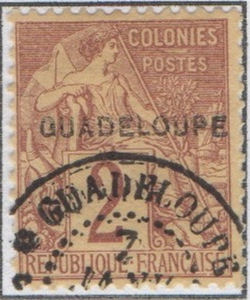
2c will not go far in telegraphy, but might conceivably have been used on a receipt.
Courtesy of Les Bottomley.
Steve Hiscocks wrote:
Modern catalogues list only one telephone stamp — that described below at No.2 — while a catalogue of some 50 years ago also includes an earlier
stamp, No.1 below, similar in type and colour to the first (1880) French telephone stamp. Dates of issue are confused in that modern sources give
the date of No.2 as 1886 while the earlier source gives it as 1892. Since the security background wording equates with that of the third (1886-96)
French issue I have accepted for the moment the 1892 date for No.2 and very provisionally, the 1887 date for No.1. It is interesting to note that the
ordering of 10 centime value stamps of the same design as No.2 below from the National Printing Office in Paris was reported in the Philatelic
Journal of America in 1893. This lends support to the later date for No.2 but the 10 centime stamp has not itself been reported and was apparently not issued.
Monaco introduced its own postage stamps in 1885 and it seems probable that the French telegraph stamps of 1868 were used in Monaco. The first
French telephone issue of 1880 may also have been used in Monaco prior to the introduction of Monaco's own very similar ones.
1887(?) Typographed in black on thin manila paper. No watermark. Imperf.
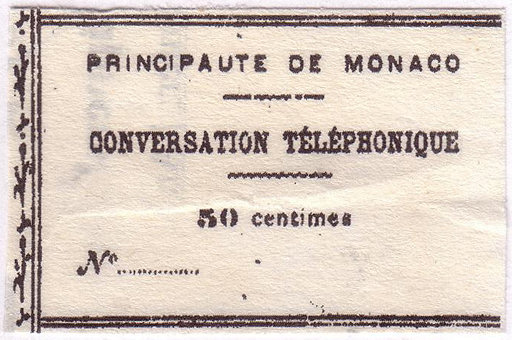
Type 1 image from RL.
It really is this small, I have seen it scanned with H2 for comparison.
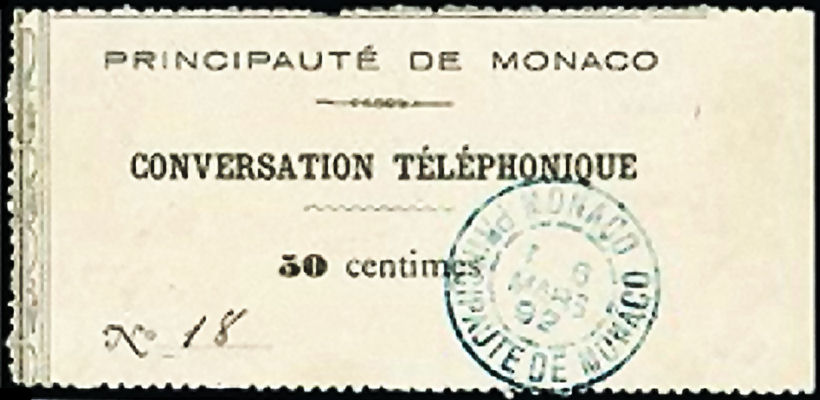
This is slightly different in the lettering. The 'N' of "No" is very different. It is dated 6 March 1892
Type 2 - Image courtesy of Spink and Son. I do not know the true size of this.
| Hisc. | Type. | Description | Mint | Used |
|---|---|---|---|---|
| H1 | 1 | 50c black / buff manila | - | - |
| H1a | 2 | 50c black / buff manila | - | - |
1893(?) Typographed on thick white paper against a yellow security printed background consisting of
repeated "POSTESETTELEGRAPHESTELEPHONES ..." by the National Printing Office in Paris.
No gum or watermark. Perf. 13½
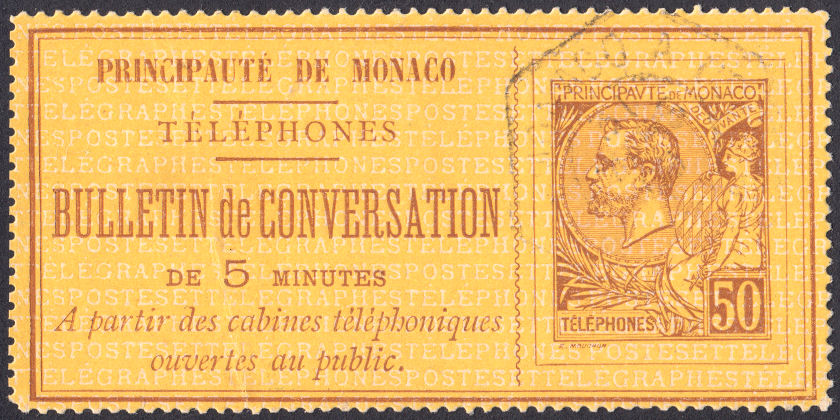
Type 3 - H2 This is not clearly dated, but I have seen one clearly dated 25 October 1894.
| Hisc. | Type. | Description | Mint | Used |
|---|---|---|---|---|
| H2 | 3 | 50c brown / yellow / white | 220.00 | 150.00 |
Hiscocks added the following note:
| Note. The paper is green on the reverse side. |

A Telegraph receipt dated 11 December 1900 for a telegram to Rangoon (Burma).
It shows the full inline cancellation used there at that time on a standard Indian form. Image courtesy of Folkert Bruining.
At the time, Burma was a province of British India.
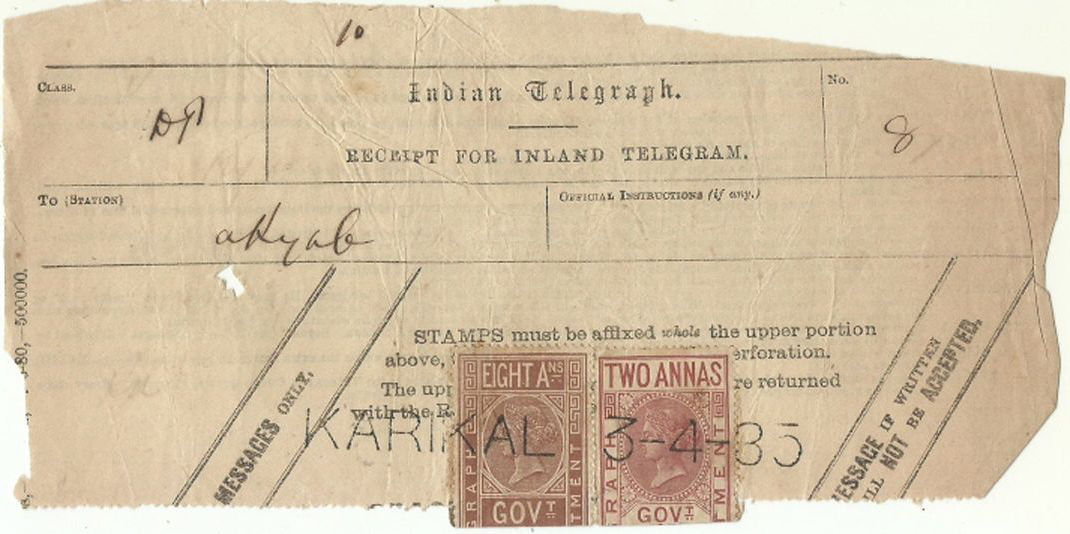
A Telegraph receipt dated 3 April 1885 for a telegram to Akyab (now Sittwe, Burma).
It shows the full inline cancellation used there at that time on a form that I'm not familiar with. Image courtesy of Folkert Bruining.
Akyab was the capital of Arakan (now Rakhine State) along the coast of North Burma.
It had been part of British India since 1826 (after the first Anglo-Burmese war).
The third Anglo-Burmese war of November 1885 brought what was left of the Kingdom of Burma into the British Raj.
From 1908, normal postage stamps were used with the round 'Bullseye' Telegraphic cancels inscribed with (usually) Pondicherry.
For more examples see (again) worthpoint(pondicherry).
I am indebted to Folkert Bruining of the Netherlands for bringing my attention to these and providing information.
Further information and images would be greatly appreciated.
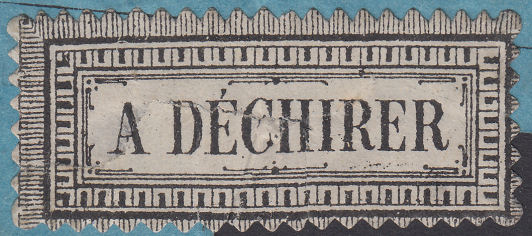
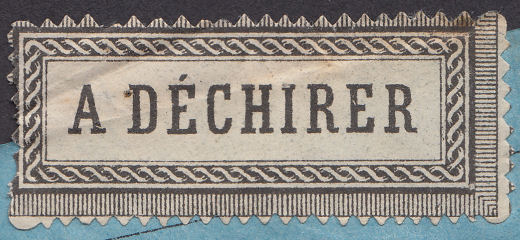
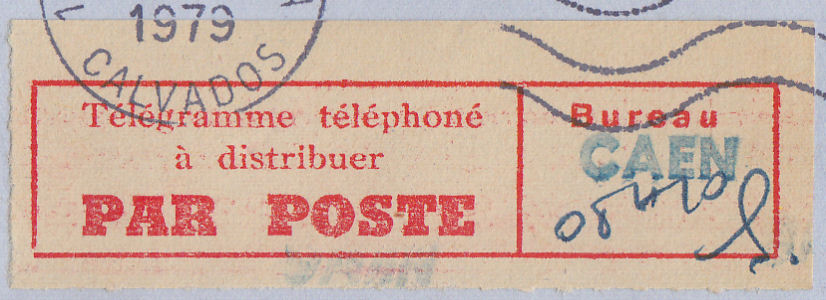
Steve Hiscocks made a start on cataloguing seals of the world in a book he published in 2007.
It was his hope to update it later, but unfortunately that was not to be.
His original book can be viewed at
Telegraph Seals: A World Catalogue. There are links from the pages to my updates.
Alternatively you can view the latest page for France.
If anyone can provide scans to help with this, I am happy to give appropriate credit.
Last updated 15th. November 2023
©Copyright Steve Panting 2012/13/14/15/16/17/18/19/20/21/22/23 except where stated.
Permission is hereby granted to copy material for which the copyright is owned by myself, on condition that any data is not altered and this website is given credit.